For a while in early high school, I began palling around with an old grade school friend of mine. Even though we were attending different schools, I was acquainted with a number of girls in her new circle from the Aksarben party days of my childhood. Spending time with her meant all of us girls piling into her mother’s old hand me down, a 1970s Jeep Wagoneer. It seemed to me, in memory, that this fine vehicle was not unlike a willing Yellow Labrador Retriever I once knew. The nicked and scratched wooden panels of that poor, rugged Wagoneer had seen more than its fair share of high school exploits. In fact it had clocked serious hours in the hands of my friend’s Cool Older Siblings. The Woody had adeptly proved to be a capable fit for this line of work. From keggers to farm parties, fast food spills, cross country concert going, impromptu street racing, bumper skiing, late night tee-peeing attacks, make out sessions and back window vomiting, this lust for life was a regular expectation and expression of this hardy Wagon, matched only by the vigorous lineage of teenage drivers.
It was during this time that I became reacquainted with the Loveland-Westside area, swimming in pools and frequenting sidewalk-less, winding roads that I hadn’t visited since my grade school years. If you have ever dallied around this fine part of town, you are surely familiar with the amount of chuckholes, dips and craters in its environ. Let me assure you none of that mattered to the robust Wagoneer and taken at a high rate of speed, those endless Loveland pits and swerves led to gales of laughter from us girls. And the homes! Those homes were some of the best I had ever spied.
I would like to have imagined that we had explored north of Pacific Street, in our early high school jaunts, particularly across from Loveland Elementary School, a local favorite of mine. But I really can’t be sure. It was a few years ago, no doubt on a Gumshoe House Stalker Mission, when I turned down a newfound street, Ridgewood Avenue. There, in the trees, concealed in plain sight, I caught a glimpse of her. 8120 Pacific Street. Could this be? There stood one of my favorite architectural addictions, as you by now know, the Shingle Style. How had I not previously detected this classic East Coast Beauty in the woods? 8120 Pacific Street was very purposefully tucked out of sight in that small grove. For one thing, she carried a Pacific Street address but you cannot possibly access the home from Pacific Street. I loved that. All the more complicated and mysterious. She had an arbor and winding paths and a screened in porch and a three-car garage complete with a louvered patina cupola. Was that a weathervane atop the garage? Every architectural delight was checked off. Were my expressions of utter shock and joy being recorded by a secret film crew? She was just the type of New England summer home some of us only dream of…. but here in our own town.
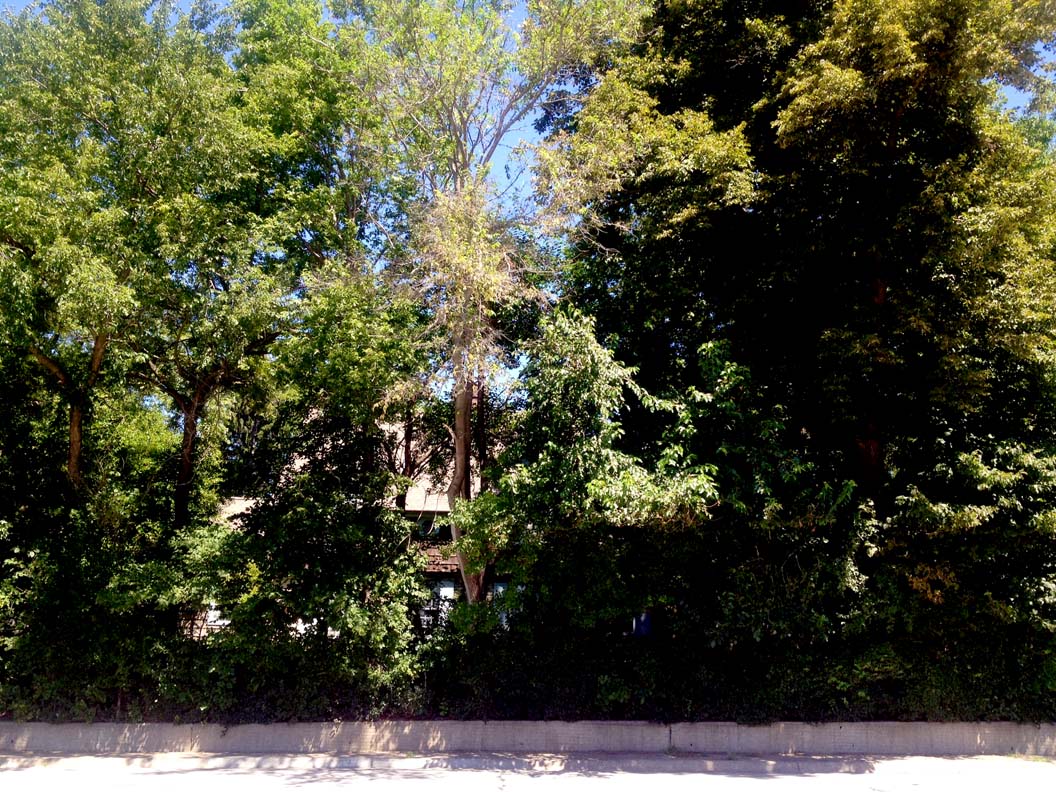
8120 Pacific, view from Pacific Street.
I will admit from the front end that I have become quite enamored with 8120 Pacific in recent years. Okay, I will say it. Obsessed. Mother of Miss Cassette has always been quick to rationalize that it takes a bit of obsession to complete any job correctly. A person must have an internal fire that drives the work. Or at least that has been my interpretation of something Mother of Miss Cassette says at such consuming junctures as these. Miss Cassette sometimes makes things up but this rationalization does seem to fit in here. Investigating a house and its humans requires such a fire. In the work of house detecting and history chasing, my aim has been to open the case and see what falls out. Sometimes this calls for a shaking and a rattling of the dossier. Usually, because we live in such a small-big city, the clues just slip together. Not this time. Just as 8120 Pacific Street was camouflaged right on a major thoroughfare, I soon found trailing her history to be as elusive.

2016 Google Map displays a number of triangle tracts in the area.
Early Loveland Area Clues
Pacific Street, which runs east-west, was named for the Pacific Ocean. It has long been considered one of the major roads in Omaha. After consulting with the Streets of Omaha book, its name apparently changed a number of times in its history, dependent on the part of town. From what I could find Pacific Street did not have any diversions from its original name west of 72nd Street.
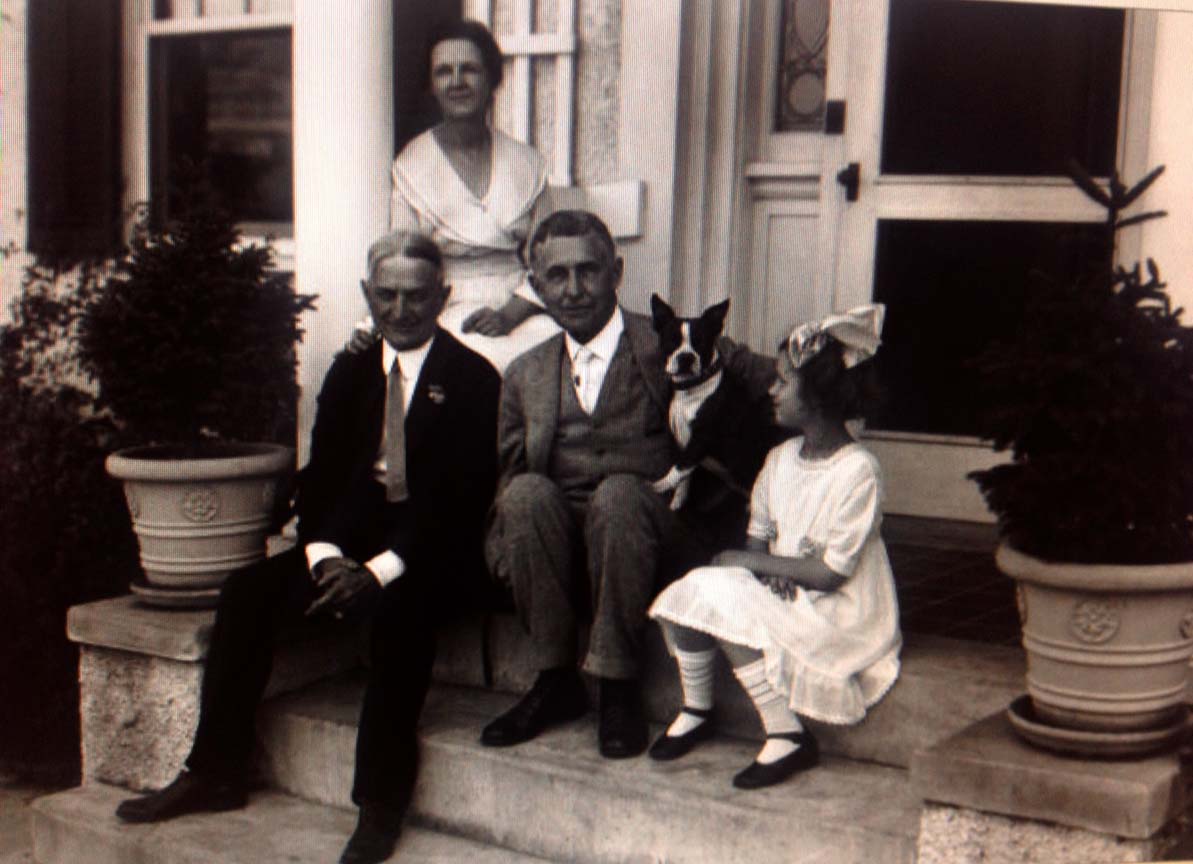
Members of the Archibald Love family on the steps of home at 8400 Loveland Drive. 1920 (Photo courtesy of the Bostwick-Frohardt/KM3TV Photography Collection at The Durham Museum Photo Archive).
Around the mid 1920s, A.J. Love or Archibald “Archie” James Love, a well-known dairy farmer, began selling plots of his large acreage on the western fringe of Omaha. At this time, the majority of Omahans lived east of 72nd Street. Check out my previous article, Brothers Lounge and the Case of the Vanishing Mom and Pop, for a history on the Midtown Gold Coast area. From the fabulous Born Rich: A Historical Book of Omaha by Margaret Patricia Killian, I learned that the early wealthy business owners in Omaha built their homes in the wooded areas with views of the Missouri River and Bluffs of Iowa. To the south of the downtown and railway area were “picturesque hills along the river as far south as Child’s Point. The hills along 8th and 10th Streets from Mason Street to what is now Riverview Park and Henry Doorly Zoo became the first concentrated ‘Gold Coast’ of Omaha in the 1880’s.” Early Money Omaha assumed “the natural residential growth of Omaha would be to the north and to the south, up and down the river.”
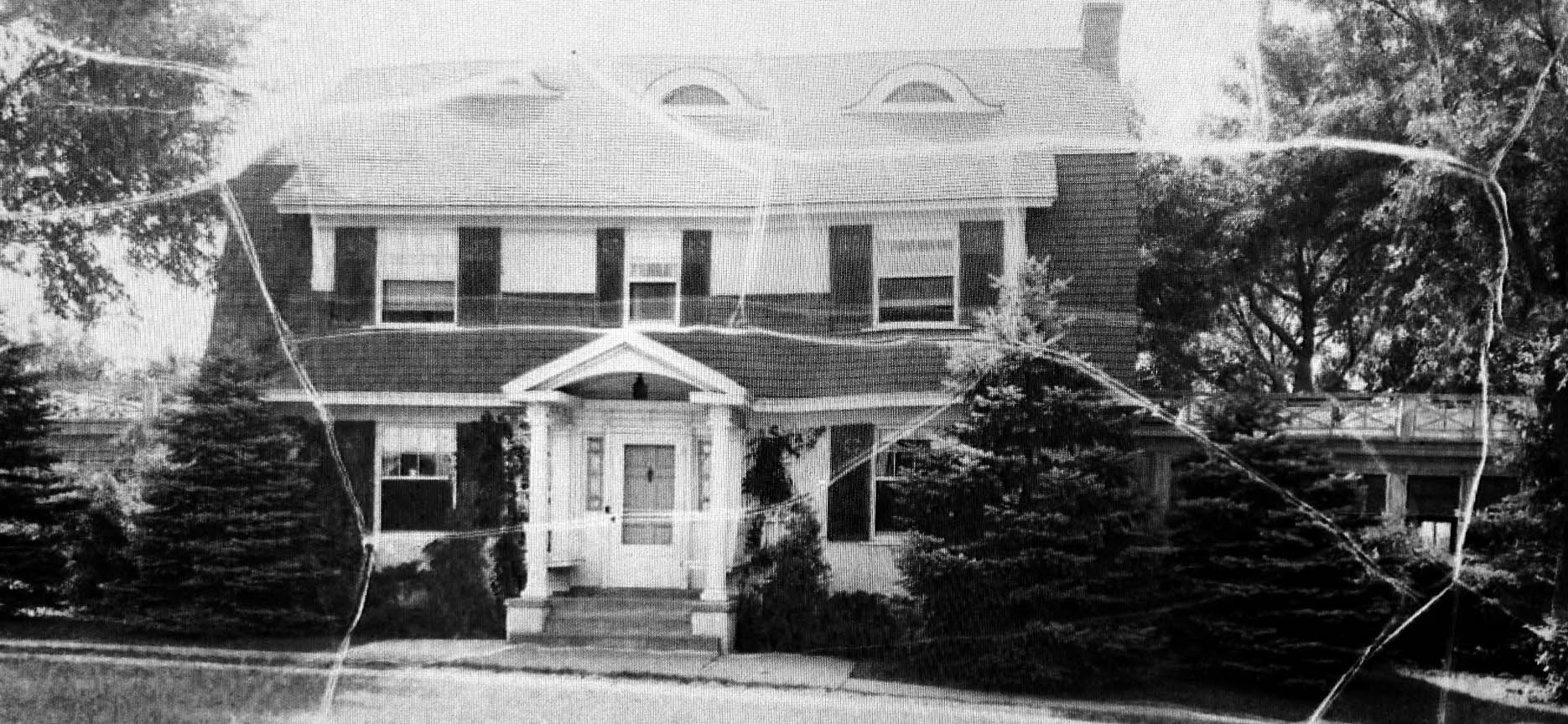
Exterior of home at 8400 Loveland Drive. 1937 (Photo courtesy of the Bostwick-Frohardt/KM3TV Photography Collection at The Durham Museum Photo Archive).
No one, to that point, had predicted the well heeled would eventually look to western farmland for an escape from city life. But Archie Love had just that idea. Apparently also known as the president of the Love-Haskell Insurance Company, Love along with his wife Harriet, were, as they say, quite comfortable and well connected. This new swath west of 72nd Street, clustered around Pacific Street, had become known as Pacific Territory. As Love began selling plots of his land, the newly affluent began to buy into the dream of Loveland—surely a simple modification of Love’s land.

Map of Loveland and what is also known as the District 66 area. Currently Loveland has been split up into three neighborhoods. Old Loveland is considered north of Pacific Street. All three areas, to include Loveland and Loveland West, are shown here.
I began to wonder if the Loveland area was developed as some type of rustic retreat, similar to the Keystone Neighborhood, where the wealthy could get away from all the hubbub of city life? Was this similar to the European aristocrats’ desire to frolic in the pasture of their pretend peasant farms? Were the glorious early homes of Loveland sprinkled along a dairy farm? The Omaha City Directories were not offering up much explanation for this rural development. Following on a tip from Martha, Omaha Public Librarian Extraordinaire, I made a date with the Register of Deeds in the county building. And this is where the investigation began to gather a bit of traction.

Portion of the Deeds Office
The Ridgewood Addition Clues
At the Register of Deeds office I was met with a most pleasant young woman named Susanna. If you ever have the good fortune of meeting with her, your great search of local deeds will be made ever more pleasant. I quickly learned that 8120 Pacific fell within the Ridgewood Addition. I surmised that an original landowner would be named Ridgewood or Ridge based off of my Loveland lead. It wasn’t long until I learned the tract of 8120 Pacific was originally owned by, none other than, “William Righter Wood and wife.” In fact they owned all of “Block 10” and from what I could gather, many, many other blocks as well. These blocks were part of very large grouping on the north side of Pacific Street. I began to daydream that William Righter Wood might have been a farmer across the way from Archie Love. What unfolded was more closely related to the Social Register than the Rural Daily News.

The Wood Family Story
Understanding the William Righter Wood property really began with digging into the Wood family. From National Register of the Society, Sons of the American Revolution Volume 1, 1902, by Louis Henry Cornish and Alonzo Howard Clark—William Righter Wood of Omaha was son of Arthur P. and Euphemia (Righter) Wood; grandson of William Wilson and Jane Ferguson (McNair) Righter; great grandson of John and Eupehmia (Wilson) Righter; great grandson of William Wilson, First Lieutenant and Quartermaster Philadelphia County Militia.

Arthur Wood
As it turns out, the Wood family was long on the Omaha social map. I was really interested to find Arthur P. Wood mentioned in my favorite book of old time Omaha movers and shakers—1917’s, Omaha: the Gate City and Douglas County by Arthur Cooper Wakely. I have mentioned this crucial book previously in the writing of the Mysteries of Omaha: 3825 South 25th Street. Arthur Wood graduated from the University of Michigan as a student in the civil engineering dept. He infamously entered the construction department of the Union Pacific Railway Co “on his second day in town” and continued until the railway was completed. Later Wood became involved with the Omaha and Northwestern Railroad Company, serving as assistant chief engineer. The Senior Wood would go on to San Diego, Texas, and San Francisco in setting up their railways. He returned to Omaha and contracted with the UP for the building of branch lines, as a partner in the firm of Wood, Bancroft & Doty. He became interested in stock raising on an extensive scale, formerly owning a fine ranch in Stanton County, where he was known to have bred fine Hereford cattle. He became partners with George F. Bancroft and “his son, William Righter Wood, of what is known as the Arwood Dairy Farm, a valuable property.”
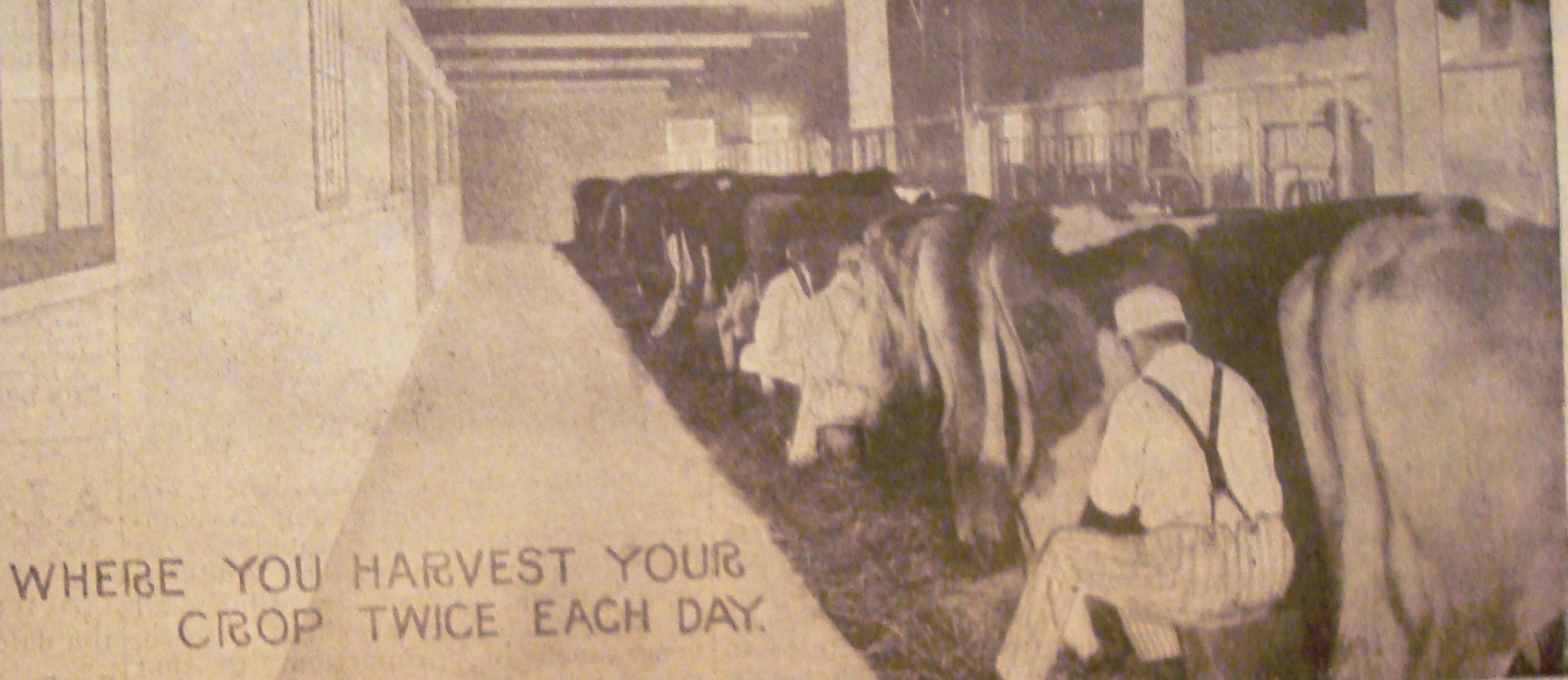
Dairy farm photo from 1911, used to illustrate what the Arwood Dairy Farm near Pacific Street might have looked like.
I became obsessed with finding evidence of the mysterious Arwood Dairy Farm. It would not take me long to find mounds of verification as to its existence and the profound effect the farm had in the shaping of dairy standards in this area. Arthur Wood was written of quite often nationally as “a cattle raiser and sanitary dairyman at ‘Arwood’ R. F. D. Station B, Omaha Nebr.” In another fascinating article, http://nlcs1.nlc.state.ne.us/epubs/A7000/B003-1908.pdf provided from 1908, refers to the Righter-Wood “Arwood Dairy.” But nothing was as interesting as the Hoard’s Dairyman, Vol. 44, an article from October 18, 1912, entitled “A Nebraska Sanitary Dairy.” Why do I love this so much? I believe it is so revealing of the times, I love voice of old journalism and this gives us a glimpse into the life of the young William Righter Wood. If this is boring to you, skip ahead a couple of paragraphs.
“The name of Arwood Dairy has become a household word in the homes of the well-to-do in the western part of Omaha, Nebraska. The reason is that Arwood furnished them with sanitary milk of uniform high-class quality. People who read and think are not satisfied with the milk ordinarily sold to city trade. They want milk that is pure and wholesome and are willing to pay well for it. The story of Arwood is the story of a young man. However, it differs materially from the time worn ‘up from poverty’ talk this is so often told. W. Righter Wood, owner and manager of Arwood, is a Nebraska farm product. He grew up on a general stock farm and early acquired a love for animals through association with them.” He attended the Nebraska School of Agriculture and graduated in 1906.

Laver family farm and grazing cattle in 1916.
He saw a need in the community. “He saw clearly that a class of city trade desired sanitary milk and was willing to play a price in keeping with its higher cost of production. No less clear was the fact that the market was insufficiently supplied with that class of milk. His third definite conclusion was that the city of Omaha offered ideal opportunity for the establishment of a thoroughly up-to-date dairy such as he contemplated.” A foundation for a dairy meant securing a suitable farm. Accordingly 160 acres of land five miles from one of the principal streets was purchased. The location is very favorable in that it is a comparatively short distance from the city’s best residence district. The land was badly run down in productivity owing to continuous heavy grain cropping. This point appealed to Mr. Wood in that he was an enthusiastic believer in the possibility of renewing fertility by practicing a rational system of dairying. Aside from location with reference to market, there was little to commend the farm. Bunch of ramshackle buildings, there was no grove for winter protection and no trees in the pasture for summer shade and no water nor luxuriant pasture. Mr. Wood became somewhat of an alfalfa crank. He believed in it as the premier of all forage for cattle. He believed it would build up the farm.”
&n
bsp;
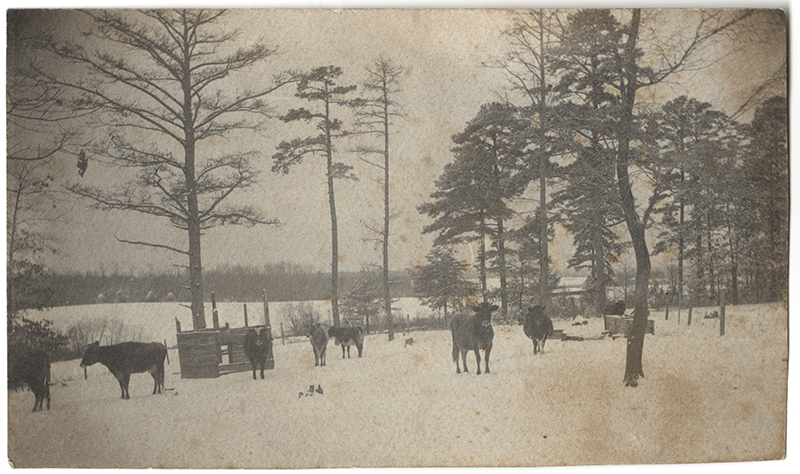
Dairy Farm from 1913.
“After cooling the milk is bottled in pint and quart bottles. Milk is strained a third time through cotton as it passes from the cooler to the porcelain-lined bottle filler. The bottles are sealed with caps especially designed for Arwood. The caps bear the stamp of the day upon which the milk is to be sold, as, for exampled milk of Thursday afternoon and Friday morning is sealed with caps having Friday stamped upon them which means that they shall be delivered Friday forenoon in the city.” The Arwood Dairy Farm and William Right Wood were both known for being “distinctly progressive.” It was easy to see how a young man raised amongst the moneyed class would have no trouble finding buyers for his high-grade milk. I like to imagine the twists, turns and hilliness of this area being grazed upon by happy cows. It is interesting to note that Ridgewood Addition–160-acre dairy farm described is five miles from the Downtown Omaha area.
William Righter Wood would marry Laura Dale and together, they had one child, Martha Eleanor. Mrs. Laura Wood was known as a member of the Colonial Dames as well as serving on the Uta Halee Home for Girls board.
I found a number of articles in the society pages about their child, Martha or “Bunny” Wood. In one such article from the early 1930s, called Sights and Sounds, the OWH frequently captured vignettes of society girls’ leisure activities around town. “’Bunny’ Wood, daughter of Mr. and Mrs. William Righter Wood, shopping, with the crisp, fresh look of a field of daisies that a blue checked gingham, white gloves, shoes and hat always impart.” Dying.
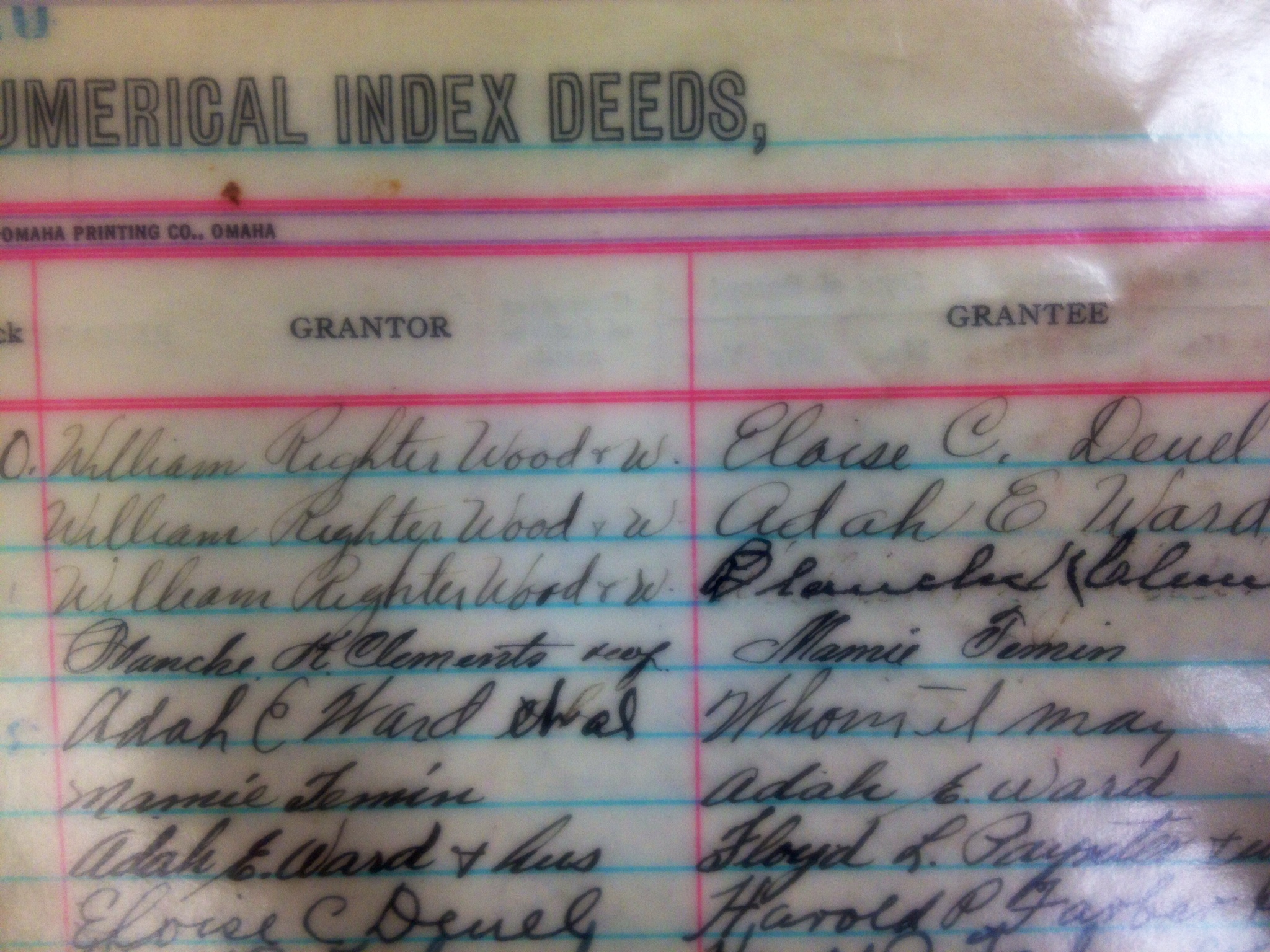
From the Deeds book. I had to laugh when Susanna asked if I was old enough or able to read cursive.
According to the Deeds office, William Righter Wood began selling large parcels of his farm in the early 1930s. I cannot say for certain why that is but I speculate this was spurred on by Archie Love’s real estate development on the southern side of Pacific Street. Or maybe he had tired of the dairy business. I found evidence that William Righter Wood would go on to operate a successful ice and coal firm, no doubt financed, in part, by the development of his own Ridgewood Addition.
The Origin of 8120 Pacific
William Righter Wood and his wife, Laura, sold Lot 0 of Block 10 to Eloise C. Deuel on January 22, 1931. Lot 0, a corner wooded lot at .87 acres, then became 8120 Pacific, on the northwest corner 81st and Pacific. Also known as Ridgewood Avenue. To this day Ridgewood Avenue enjoys a short jagged run throughout the District 66 area and even does some double time as 84th Street at one point. It is interesting to note that the Ridgewood Addition is considered the “Old Loveland Neighborhood.” Part of what attracted to me to this grouping of parcels is the peculiar street planning and the intentional shunning of the grid plan. As you can see from this early map from the Registrar of Deeds office, there are some great angles going on in this part of town.

Tom, “The Mayor of Benson” printed me off this cool early Deeds map of the area.
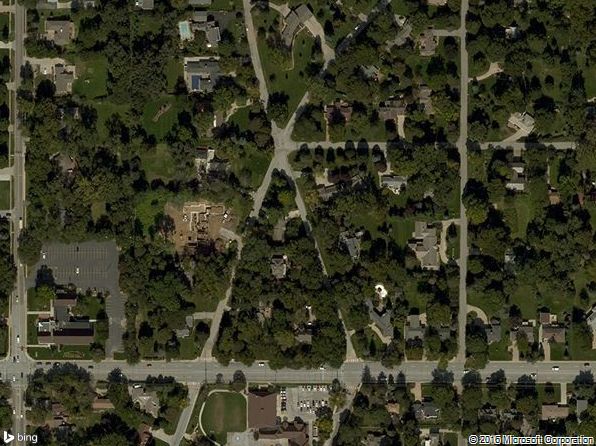
2016 areal map.
8120 Pacific is situated on a little wooded triangle, which I think of as a nice-slice-of-cheese shape, nodding to its dairy farm origin. 8120 Pacific is 4,157 square feet and is two and half stories. It has six full bathrooms and five bedrooms.
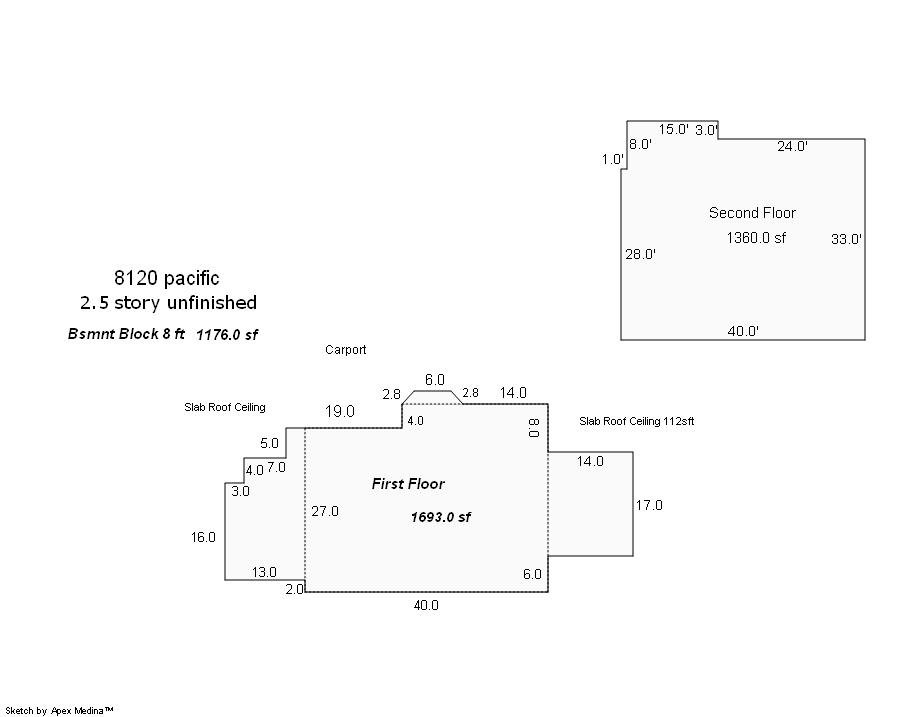
Floor plan from the Douglas County Assessor site.
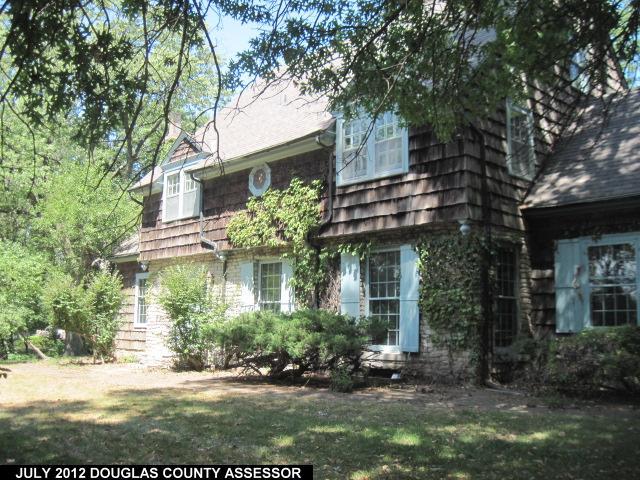
From the County Assessor site.
To my estimation (and with confirmation from Identifying American Architecture by Blumenson and the incredible Visual Dictionary of American Domestic Architecture by Rachel Carley,) this glorious house is a Shingle Style Colonial. It has a strong gable wood shake roof with long slopes. Part of my adoration of the Shingle Style is the understatement, the nod to English-American utility. There is no flash. It is all about quality, class and those weathered shingles, from roof to foundation walls, just get better with age, in my opinion. This uniquely American style is most often seen in New England. Yes, please do think about of the rambling mansion in Grey Gardens. (Think of it often, as I do.) I like to dream of the Shingle Style in the hot summer months, when old money families moved from town to the country. Oh my. With its beginnings in the Boston area in the 1880s, the Shingle Style spread across the country over the next decades. You will most often see the Shingle Style in the modest Cape Cod cottages in the Midtown area. They are known for their diverse forms, blending different styles of architecture (mostly of the Queen Anne or Colonial style variations) with the cladding of wood shingles.

North side of the house with a arbor path leading from garage to home. Is that a modest porte-cochere, I see? You know how I obsess about porte-cocheres.
Imagine, if you can, the selection of this unchartered neighborhood back in 1931. I began thinking about the type of people who chose this Shingle Style architecture, nearly fifty years after it was developed. They had a confident eye. They were certainly well off and very likely had spent time in the East Coast. They specifically chose this country style most likely making a move from the city proper. Was this their getaway home, like the Keystone neighborhood had been originally? Much to my dismay, I could not find the name of the architect or builder. But the name Eloise C. Deuel was the only verification I would need.
The Lake and Eloise Deuel Story
By all evidence, Lake and Eloise Deuel designed, along with their builder, the preppy country Colonial at 8120 Pacific in 1931. The move was a progressive one, intentionally away from the too-palatial, old-fashioned residences of the Gold Coast and Dundee-Fairacreas neighborhoods. Imagine. The Deuels had the means and connections within the real estate, construction and property management community of which they were a part.
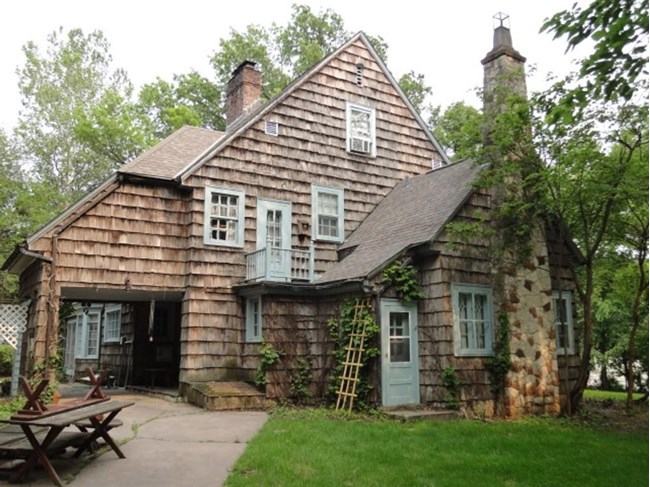
West side of the house, featuring the porte-cochere, a small lookout balcony and the best cobblestone chimney.
But I’m getting ahead of myself. Let us first evaluate some of the evidence I was able to track down on this couple. Much like our previous subjects of such prominent families, we must, of course, acknowledge the name of the Deuels, who dominated newspaper accounts of Omaha Society. Miss Cassette was simply astounded by the amount of press Lake Deuel received, even as a toddler. From the May 24, 1891 Omaha World Herald, “Mrs. Charles Deuel and Master Lake Deuel were at an impromptu May party for some very little guests.” Lake was in the papers frequently as a child and in the society pages throughout his whole life. And with a name like Lake Deuel, it was his afforded birthright. The Deuel name was up there with the Redicks and the Gallaghers as premiere families of Omaha. Charles Deuel, father of Lake was one of the United States National Bank founders. He owned a good amount of property in town, thought to be some of the earliest homes in Omaha.
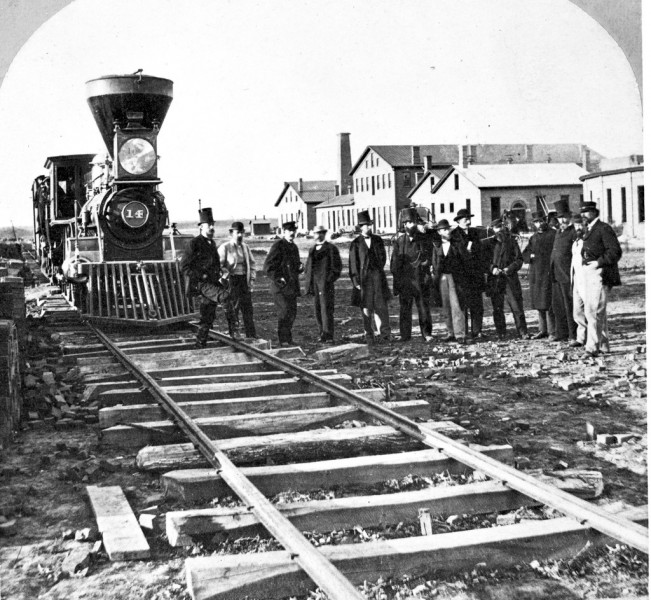
Union Pacific. First tracks are laid.
Charles Deuel’s parents were Mr. and Mrs. Harry Porter Deuel. Harry Deuel was regarded as the oldest railroad man in Omaha when he died. Deuel ran a successful steamboat agency in the early years of Omaha, and later worked for the Union Pacific and Burlington Railroads. The Deuels most certainly knew the Woods through the railroad and also social ties. On the other side of the family, Lake’s mother was Mary Lake Deuel. Her grandfather was George H. Lake and the late Judge George B. Lake was her father, yet another esteemed Omaha pioneer. Judge George B. Lake was one of the first justices of the Nebraska Supreme Court. From a 1920s article I read,“No family of the old territorial days of Nebraska has a more interesting history than the Lakes, it is said.” Lake’s grandmother was Mrs. Abbie Gertrude Hayes Lake, widow of Judge George B. Lake. Grandmother Abbie would go on to live out her later years with her son, also well known, Dr. Frederick W. Lake, in his home was 5010 Capitol. Grandmother Abbie was godmother to Senator Hitchcock, another well-heeled connection in these parts. Is this all too much?

5010 Capitol Home of Dr. Frederick W. Lake, Lake’s uncle. Grandmother Abbie Gertrude Hayes Lake died in this home.
I came across an article for the funeral of Mrs. Mary Lake Deuel, Lake’s mother, dated December 20, 1909. Her funeral was apparently postponed, as various family members, to include Lake Deuel, who was away at Princeton University, could not get home in time for funeral. Aside from the early death of his mother, my mind began to reel. It was then that I knew Lake had been Ivy League. He was well versed in summering at the prep island shingle-style beach house or traversing to the shingle style country cottage of school friends, he was certainly adept in legacy events and nuanced in the ivy covered private club form. He had also learned the high art of the understatement. I imagined 8120 Pacific Street was starting to take shape long ago.

Cannon Green Princeton campus in 1909
In September 17, 1913 there was a mysterious announcement for “Society Wedding Announced for Lake Deuel engaged to Miss Mildred Rogers. Both are popular members of the young, Country Club set. Miss Mildred had completed her school and traveled extensively in Europe. Granddaughter of prominent figures in Omaha and one grandfather, a heavy ship owner. Date of the wedding to be announced later.” The mystery part was that I never did find that announcement. Not a peep. Lake Deuel continued to be covered in the papers for his many social outings. The wedding must have been called off. By June 11, 1916 “Charles Deuel and daughter, Miss Blanche Deuel and son, Lake Deuel, have moved into their new home at 5204 California Street.” Charles L. Deuel was a treasurer for the McCord-Brady Company on 12th and Leavenworth.

McCord-Brady Company, a grocer, now site of the Bemis Center for Contemporary Arts. 12th and Leavenworth Streets.
Can we just stop for a moment and affirm that Lake Deuel is possibly the best name ever? Aside from being quite the man about town, Lake spent his days an accountant. In the summer of 1917 the papers announced Lake as a new member of the Omaha ambulance unit and “will probably be exempt from assignment to any other branch of the service.” I understand that many famous people were ambulance drivers in the First World War but this assignment would appear to be on the local home front. I assumed that this was a move to keep Lake Deuel World War I. I would find out later, through numerous articles through the decades that Lake had significant health issues.
In 1924 Lake Deuel once again made the papers for erecting a new apartment hotel on the historical site of his grandfather’s home, the late Harry P. Deuel, Omaha railroad pioneer. The Harry P. Deuel home on northwest corner of 19th and Dodge was razed when Dodge Street was graded. Lake, along with his builder-property manager created a new downtown apartment hotel, the Princeton, named after his alma mater, no doubt.

Here we see the Princeton apartment hotel which later became solely apartments in the 1950s. This structure was south of the famed Music Box Theater, seen in the very right side. The three-story apartment building (looks like it ended up being two), housing thirty-eight unfurnished suites was built by the Fred L. Heyn Company. The provision was made for the erection of four additional floors in the future. This apparently never happened. (Photo courtesy of the Bostwick-Frohardt/KM3TV Photography Collection at The Durham Museum Photo Archive).

Lake Deuel
In May 3, 1929 Lake Deuel and Eloise Chambers applied for a marriage license. Both were 39 years of age and according to the 1930 Census, this was Eloise’s first marriage. I am almost 100% certain that Lake had not married previously. The 1930 Census also revealed the couple, now both 40, residing with two live-in servants, Alice M. Chambers, age 67 and Anna Manthey age 60 at 5202 California Street. As you will recall Lake’s father’s home was at 5204 California Street. In April 26, 1931 the“Lake Deuel residence” as it would continue to be called for decades, “at 5202 California Street, was sold to Mildred W. Haggart. A large home contained three baths and a two car garage.”
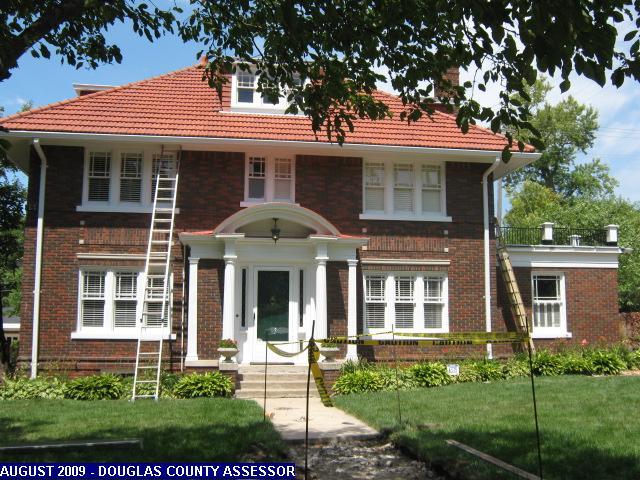
5202 California
This is where the documents became a bit more precarious. Although we know Eloise Deuel bought the land from William Righter Wood in 1931 and we know Lake and Eloise sold their home in 1931, the City Directory does not list them living at 8120 Pacific until 1934. This could be explained by an inaccurate City Directory, the fact the address was so far west and not acknowledged as Omaha or perhaps, maybe the house wasn’t really built until 1934. To add to the mystique, I found through a genealogy site, in 1934 Mrs. Ada Archer was the “buyer of 8120 Pacific.” I could not find her name again tied to the home, nor was she ever the buyer according to the official Deeds Office. Interestingly Mrs. Ada Archer had been quite the Omaha society woman in the early teens. In 1911 her attendance was noted at a beautiful house warming party on Florence Boulevard. In October of 1913 the gown she wore to the AkSarBen Coronation Ball described in exquisite detail in an article about the fashions seen at that year’s ball. I was perplexed.
And what about the enigmatic Eloise Chambers Deuel? As stated, Eloise was married for the first time at age 39. She did not have children. This was unusual in this part of the country but not necessarily odd for the East Coast. A proper woman of this order might have chosen not to be married. If she happened to be an heiress, for example, or of considerable means, it didn’t matter. If she had traveled in the worldly society, her single social life would not have been dissimilar to her married friends’ lives. From what I could unearth, Eloise’s family lived in Iowa. I was unable to track down any clues as to her life. She was not in the newspaper and did not appear to be in the prosperous circles that Lake Deuel was accustomed. It was puzzling to me that the home was in her name. I invented all sorts of scenarios, which I will leave out of this article but I do have my suspicions.
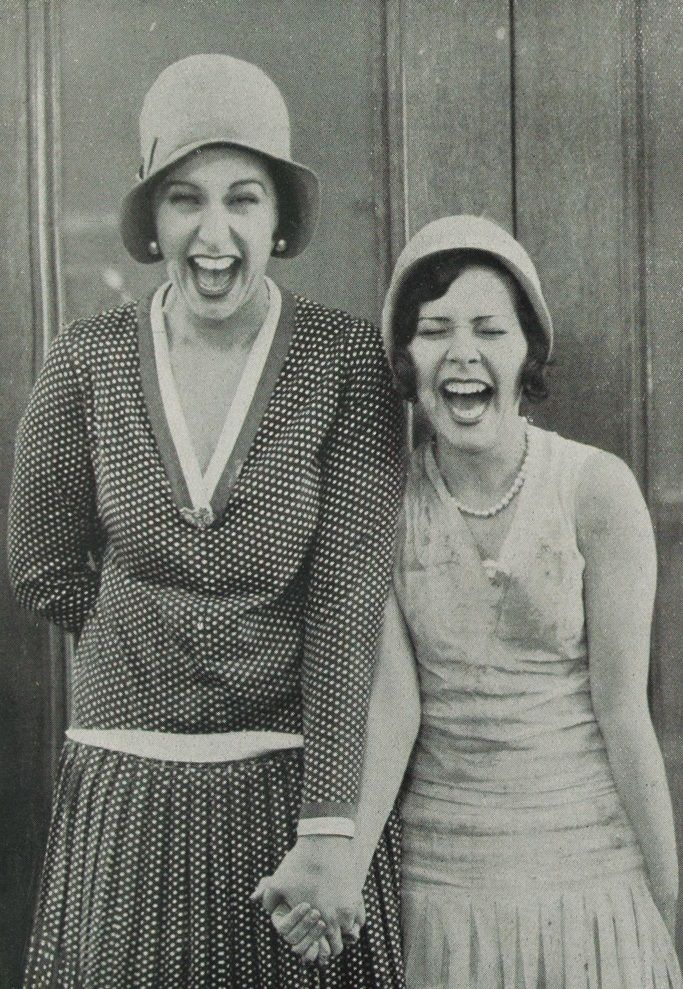
Here is how I prefer to think of Eloise Chambers in the 1920s, previous to marriage. Not an old maid by anyone’s standards. Having Fun!
Lay of the Land
1934 finds Lake Deuel and Eloise Chambers Deuel firmly living in 8120 Pacific Street. At this juncture, Lake is listed in the City Directory as an accountant. A bit more digging uncovered that he worked for the John M. Gilchrist Company. Their only neighbors in 1934 were the Paul Clark family at 7907 Pacific (this address no longer exists), the David Callahan family at 8005 Pacific (this address no longer exists) and the Loveland Elementary School, across the street at 8201 Pacific. This fantastic looking school was built in 1932.
 Loveland Elementary School. One of my favorite school buildings. Check out my previous story on this topic at The Case of the Vanishing School: Oakdale Elementary.
Loveland Elementary School. One of my favorite school buildings. Check out my previous story on this topic at The Case of the Vanishing School: Oakdale Elementary.
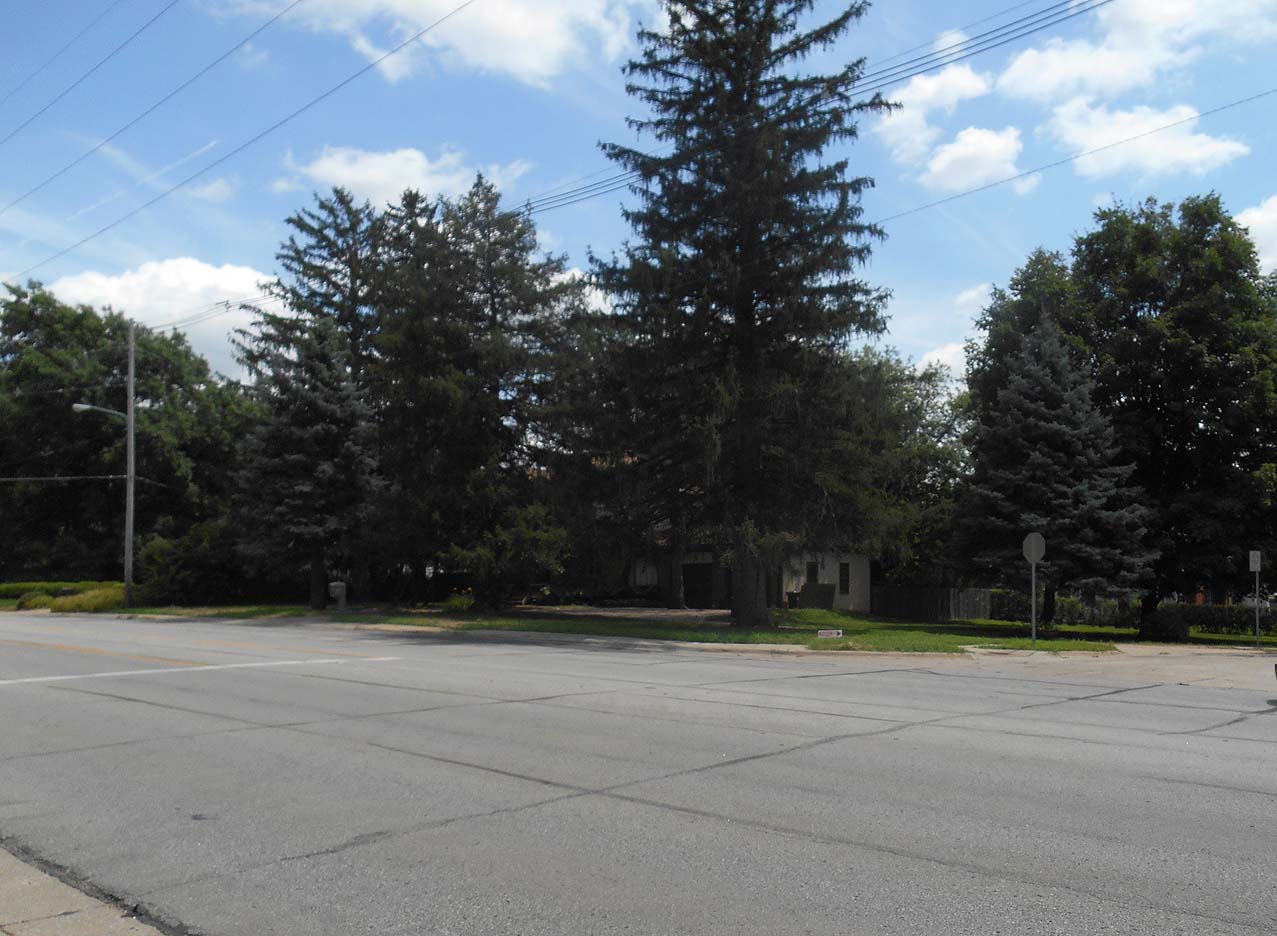 Across Pacific and to the east.
Across Pacific and to the east.
One of the more interesting things that I discovered was the home to the north of 8120 Pacific, at 810 Ridgewood Avenue. This large brick house was built in 1908, the oldest home by far, in this neighborhood. It also sits on the slice of cheese triangle. I have reason to believe that this glorious home is the original William Righter Wood house.
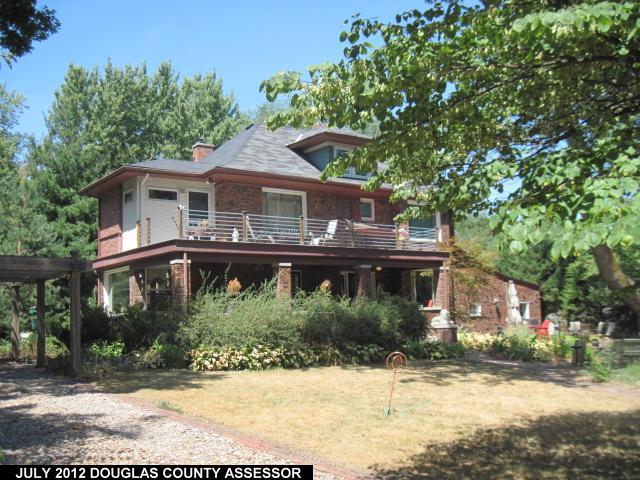
The William Righter Wood House? Just north of 8120 Pacific.

Entrance to home to the north of 8120 Pacific is 810 Ridgewood Avenue. I plan to research this property but will have to wait for another story. Surely, by now, you have picked up how I can get side tracked very easily. This is a great property!

857 Loveland, the plat just west of 8120 Pacific, was built in 1932. This is an absolutely gorgeous property. I will confide that Mr. Cassette has announced many times, when I become annoying, that he would like to live in 857 Loveland and I can live in 8120 Pacific. He has said that we could, on occasion, set times to meet on the grounds between the two homes. It is hard to be offended by this dream scenario.
 Ridgewood Avenue outlining the triangle plat.
Ridgewood Avenue outlining the triangle plat.
By 1935 Archie Love was listed as living at 9000 Pacific and the Charles Reese family resided at 9103 Pacific. In 1937 there were six addresses listed west of 8120 Pacific. The neighborhood was starting to take shape.
Lake Deuel died suddenly on March of 1938. He collapsed with a heart attack at Nineteenth and Leavenworth streets and died before the ambulance could reach him. The OWH stated that Lake was 47 years old, had been a public accountant for 15 years and that Eloise K. Chambers was his only survivor. Eloise Deuel continued to live in the 8120 Pacific with two servants for a number of years. She sat on the board of YWCA. By 1940 Eloise was ready to sell 8120 Pacific Street. On June 19, 1940 Eloise sold the stately Colonial home to Harold P. Farber.

By the time of Eloise’s death in 1960, she resided at 122 S 39th St. Not exactly what I was expecting.
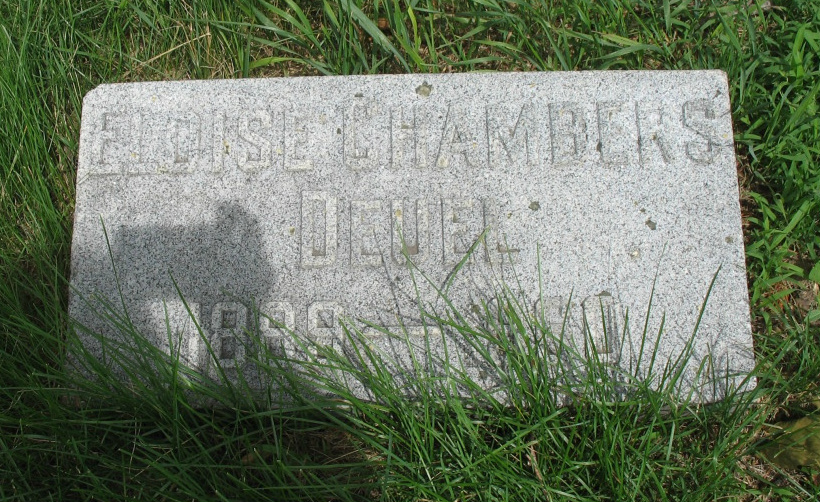
Headstone for Eloise Deuel 1899-1960. Eloise is buried at Prospect Hill Cemetery.
The Harold and Lillian Farber Story
Harold P. Farber bought the rustic New England charmer at 8120 Pacific Street in 1940. It must have been such a different neighborhood by then. I began my sleuthing by looking for clues into the life of Farber. The 1930 U.S. Census revealed 2,084 Jewish Russians were living in Omaha, many of whom were first-generation immigrants who had fled religious persecution in the Russian Empire. Harold P. Farber was one such immigrant having been born in 1903 in Russia. By 1934 Harold and his wife, Lillian Farber lived at 3716 Dodge Street, the Radcliffe Apartments. For more details on the Radcliffe, check out my previous story Then & Now: The Radcliffe Apartments.

3716 Dodge, one part of the Radcliffe Apartments.
By the 1940 U.S. Census, Harold P. Farber was age 37. Lillian was 32. They had two children: James, age 6 and Nancy, 4. Lillian’s brother, Vernon Schiff, age 23 lived with the family as well. Their home in 1940, previous to their move to Loveland, was at 2027 N. 54 St., in the lovely Country Club Neighborhood.
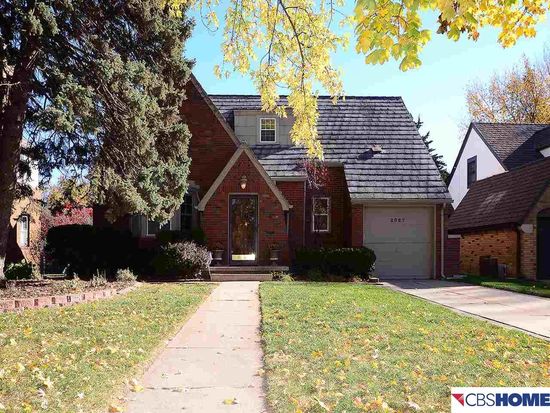
2027 N. 54 St.
To say that the Farbers were conscientious society people would be an understatement. It was easy to find a bushel of evidence to support their many charitable contributions–article after article about their many activities. Harold was in the OWH frequently for his Highland Country Club involvement and his golf games. Lillian was featured for the many luncheons and teas she hosted and attended. She was quite active in the Jewish community, she attended a variety of parties, co-hosted many gatherings large and small. These are just the kind of people that we detectives hope to investigate, because there was just so many countless articles about them in the paper. When the Farbers moved into 8120 Pacific Street, Harold was chairman of the Highland Country Club committee, heading up a group to plant more than 250 evergreen trees on its site at 132nd and Pacific Street. In 1924 Omaha’s Jewish community celebrated opening its own exclusive country club, Highland Country Club, in response to policies at established country clubs, which excluded Jews. The Highland later became Iron Wood Golf Course. This is now site of Heritage Assisted Living Home at Sterling Ridge, various offices and the Tri-Faith Center project.
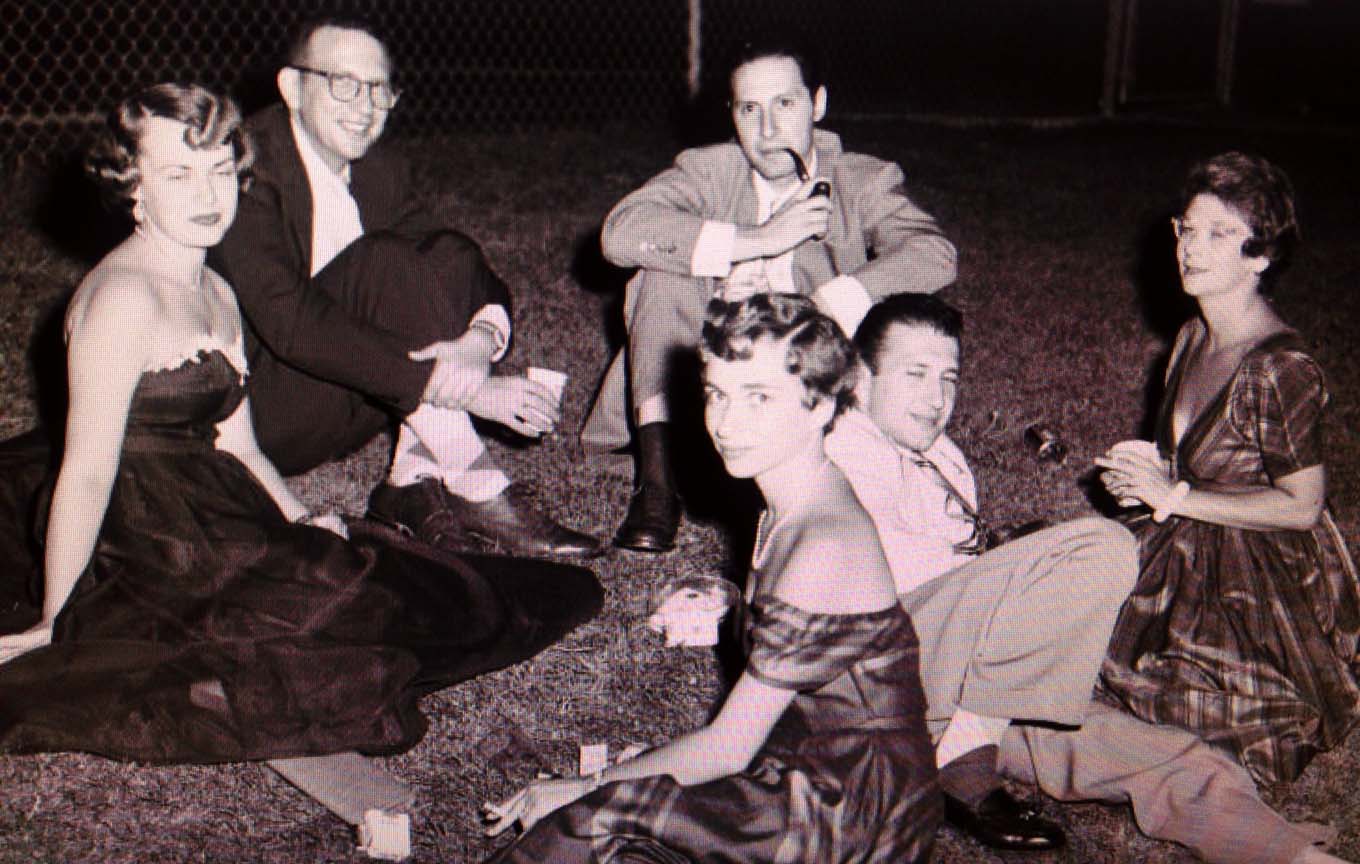
Three couples sit on the lawn for an Omaha Symphony Concert at Highland Country Club. John Savage, August of 1953. Gorgeous.
In 1941 Lillian was an Omaha N.F.T.S. Sisterhood of Temple Israel member. Numerous teas held there and she was featured as a member of multiple Women’s Councils.
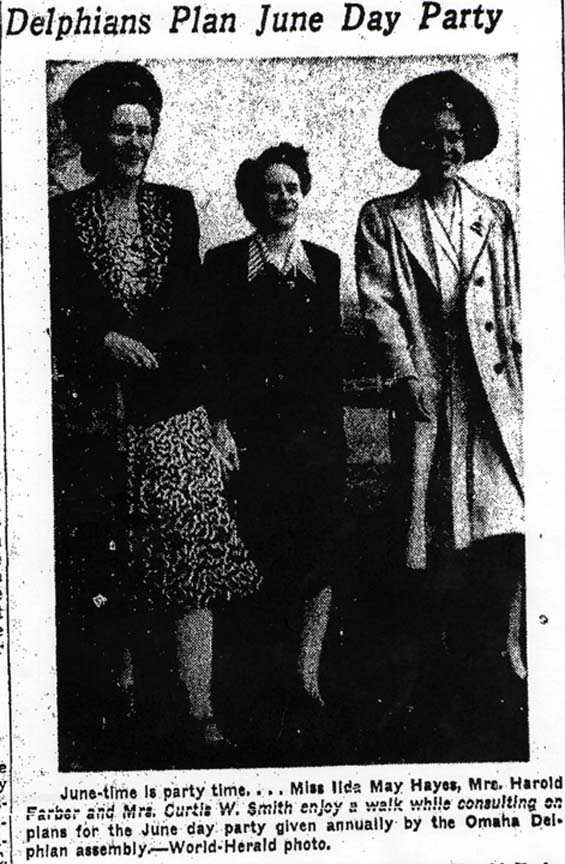
PHOTO: Mrs. Farber Delphians Plan. Here she is featured in an article from May 31 of 1942. I just love this photo, as it was rare to see an action shot featuring women in those days. And you know Miss Cassette just loves these clothes.
I turned up an obscured bit of evidence from January 29, 1948. Les Pfeifer, 37, claiming to live at 8120 Pacific Street, had suffered a fractured right leg and a brain concussion when hit by a car in the Midtown area. I was unable to connect him in any way to the Farber family and in fact, could not even find a smidgen of case history on him. Based on later frequent ads that the Farbers ran for domestic help, I assumed he was a houseman or a gardener but he could have been someone’s in-law, for all I know.
The City Directory of 1949 listed Harold Farber as secretary of the Service Life Insurance Company. Other reports that I uncovered showed that he later became vice president of Building & Investments Co., located on 4th Floor of the Service Life Building at 1904 Farnam Street. J. Sid Morgan was president. The Service Life Insurance Building, of which the building was named, had John A. Farber listed as president and Ajon F. Farber as vice president. These had to have been relatives.

Service Life Insurance building at 1904 Farnam Street in 1944. Just look at that. When Downtown Omaha was the place to be. (Photo courtesy of the Bostwick-Frohardt/KM3TV Photography Collection at The Durham Museum Photo Archive).
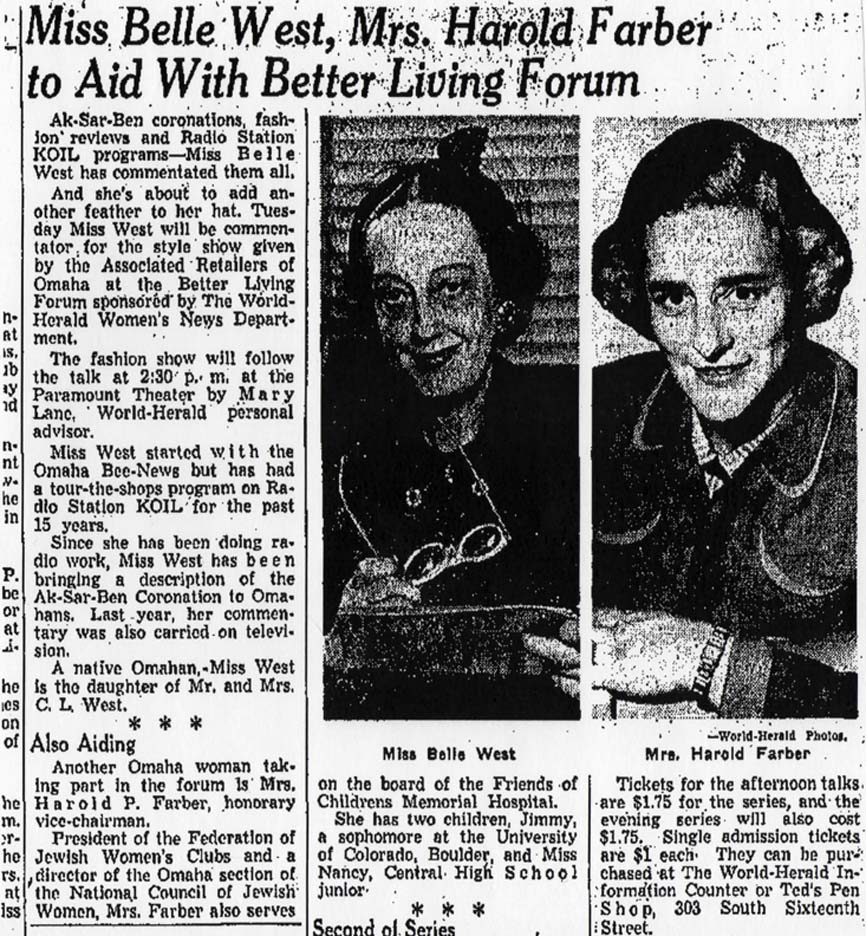
I do adore this article on Miss Belle West and Mrs. Harold Farber from the OWH September 28, 1952 addition.

Work starts on Temple Israel. In February of 1953 the Farbers were both active with their involvement in the new building of Temple Israel, a 14 acre tract between 69th and 72nd Streets. Harold Farber would go on to be vice president of the Temple Israel in 1957. Additionally the civic minded Farbers were Friends of the Children’s Memorial Hospital and very active with this hospital. Children’s Memorial Hospital opened in 1948 and was located at 42nd and Dewey. It is now Children’s Hospital and Medical Center.

I discovered the sweetest article from April of 1953, featuring prominent Omaha men “cooking.” The article was titled, Men Invade the Kitchen. Here, Lillian, Harold and Miss Nancy are featured. I do wish this were a better photo. How darling is Miss Nancy’s little necktie?

Look at that Society of Amateur Chefs apron. Here we have Chefs Farber and Peacock. I was able to track this photo down, showing Harold on the left. I am not sure what the event was but this is so great. (Photo courtesy of the Bostwick-Frohardt/KM3TV Photography Collection at The Durham Museum Photo Archive).

An unknown couple stands by a water pump and trough at the Highland Country Club in 1953. I love this! Doesn’t the fellow operating the pump look like Omaha’s Liev Schreiber? And that woman holding the golf club. Divine hair. Harold must have been as well known for his cooking, as he was his golf game. He was often featured for his golf score and involvement at the Highland. (Photo courtesy of the Jon Savage Photography Collection at The Durham Museum Photo Archive).

There were multiple ads throughout the Farbers’ ownership of 8120 Pacific Street, looking for domestic help.
In yet another ad, “Housekeeper—4 adults. Have extra help. Private room. Air conditioned. Good home for right person. Excellent wages.”Around this time period there were many clues provided about James “Jim” Farber’s involvement in the theatre. In 1954 the young Farber was featured various times for his work as a Creighton theatre student. I assumed that the “four adults” written about in the servants’ ads were referring to the four Farbers, with Jim and Nancy now in college. But a part of me wondered if the children away at college and other family members had moved in. The empty Les Pfeiffer file was driving me nuts. I wondered how many staff it took to care for the home and almost an acreage. The cook, the houseman, the gardener, the cleaning lady?
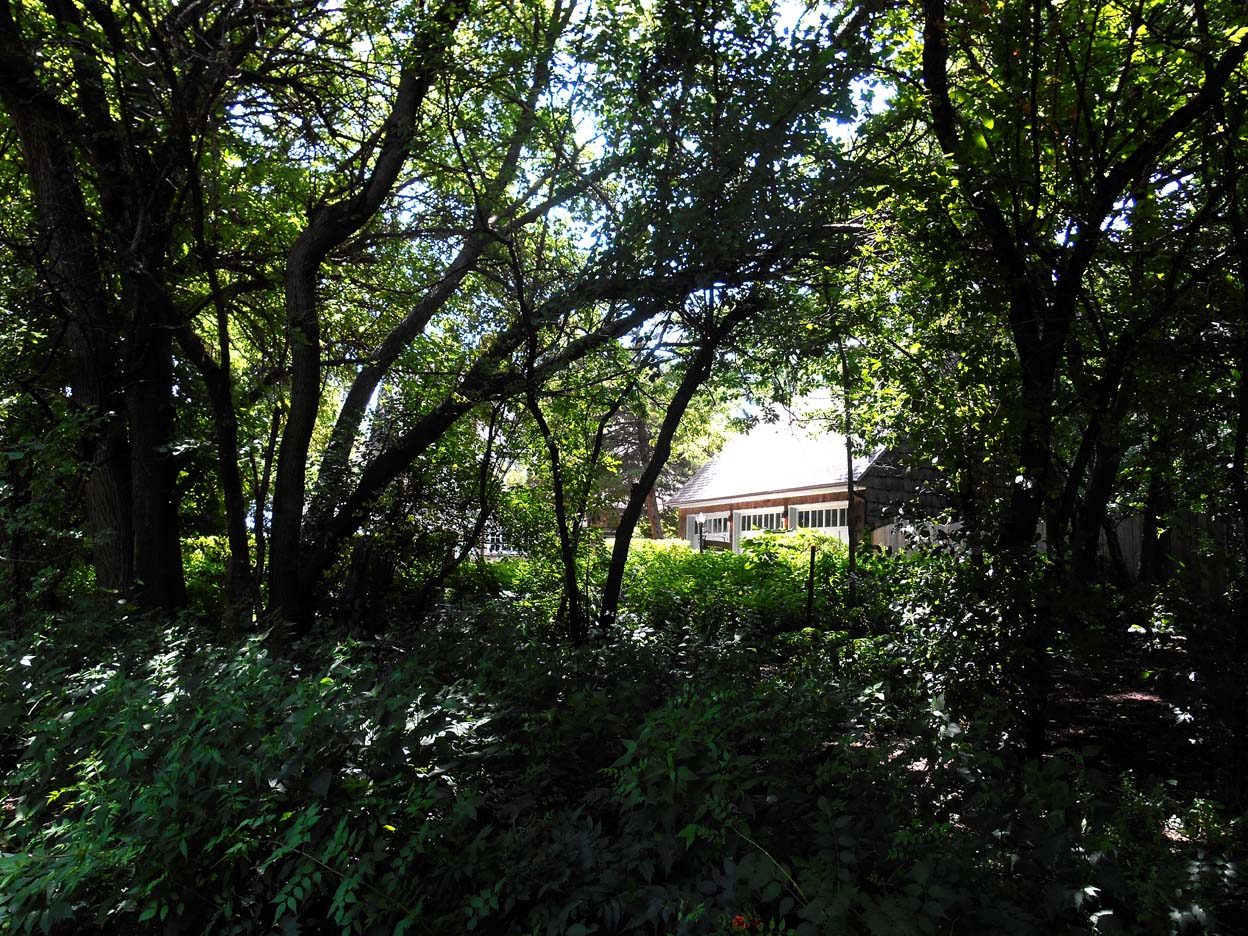
Beautiful three car garage of 8120 Pacific Street, obscured from view.
By the mid 1950s, the Loveland Neighborhood was in full motion and considered an affluent neighborhood, known for its meandering, private surroundings. The intentional lack of landscape architecture and the absence of street planning and provision were unlike any established posh area in Omaha. It’s assumed rai·son d’ê·tre was to keep the wandering eyes away but it also forces one to slow down and take it all in. (Unless of course you are a high school girl with a Wagon full of teenagers.) The Loveland homes were among the most glorious in town with winding, rough, country roads and a spacious natural setting that one could find east of 72nd. Where else can you find the exclusive roads, hideaways, both unpaved and covered with mud, both classically preppy and fraught with peril? The terrain, to this very day, is magnificent, and of the highest order. We know now that this is rich, hardy soil thanks to William Righter Wood.

Hidden from sight.
I cannot be sure why, but in October of 1956, Harold P. Farber sold 8120 Pacific to Ace R. Cory. According to the Nebraska Jewish Historical Society, Lillian Schiff Farber died in 1995. Harold P. Farber died in 2002 and is buried at Temple Israel Cemetery. This active, fun couple made a large contribution to the shaping of Omaha, as we know it.
The Ace R. Cory Story
In October of 1956 Ace and Carol Cory moved into 8120 Farnam. Ace must have been just the kind of person that his storybook name implied. After piecing together clues from his life, I was sure of his strong charisma and high energy. Ace Rowland Cory was an Iowa boy who had an early sense of adventure. As a student at the University of Michigan, he became a national swimming champion, apparently achieving All American Status. “He was preparing for the Olympics as a member of the U.S. relay team, when the Olympics were cancelled by the onset of World War II. Mr. Cory immediately joined the Marines and served throughout the war in the Pacific as a Marine Corps Second Lieutenant. During the Korean War, Mr. Cory returned to military service as a Marine Corps Captain.” When Ace returned to civilian life, he became an officer of the Cargill Grain Company. For nearly two decades he ran Cargill’s operations in Omaha, trading grain on the world market and serving as president of the Omaha Grain Exchange.

Remember the Cargill Grain Company right in the middle of town? I about flipped when I found this photo. I had not thought of this grain silo complex in forever. Here it is featured just south of the Crossroads Shopping Mall. For those of you who don’t remember this, this is Crossroads Shopping mall. The street near the bottom of the photo is 72nd Street and the street running almost the full length of the photo is Dodge. Notice to the top right, the 76 West Dodge Drive-In at 7646 Dodge Street. This was demolished in 1983. Thanks to reader Thom, who caught my mistake of labeling this the Golden Spike Drive-In! (Photo courtesy of the Bostwick-Frohardt/KM3TV Photography Collection at The Durham Museum Photo Archive).
In July of 1957, after living at 8120 Pacific for about a year, Ace and Carol Cory had a daughter. I cannot be sure of their years of birth or order, but I believe Ace and Carol had three children together: Jeffrey, Catherine and Kim.

The Omaha City Directory listed Ace Cory, in 1959, as manager of the Cargill Inc., which operated the Omaha dock’s grain elevator. (Photo courtesy of the Bostwick-Frohardt/KM3TV Photography Collection at The Durham Museum Photo Archive).
In his social life, Ace was known to be an avid sailor and also a hotshot golfer at the Omaha Country Club, a private country club at 6900 Country Club Rd of which the Corys were members.

The Omaha Country Club at 6900 Country Club Road. The interior of the new clubhouse in 1927. I believe the original building (from the 1920s) of the OCC to be one of the most beautiful environs in Omaha. That exalted beamed ceiling. I cannot speak for the new additions.

Here is another photo from the OCC in this time period, just because it is fantastic. Look at that pool posing. Just magnificent. (Photo courtesy of the Jon Savage Photography Collection at The Durham Museum Photo Archive).
By 1959, Ace and Carol Cory had put 8120 Pacific Street up for sale. This is where things got more exciting for me as a house detective. It is no wonder that Ace would go on to become a realtor. Just pore over these incredible descriptions of our focused home. If realtors of today could learn to write like this, we would all be a lot happier. I am sure of it.
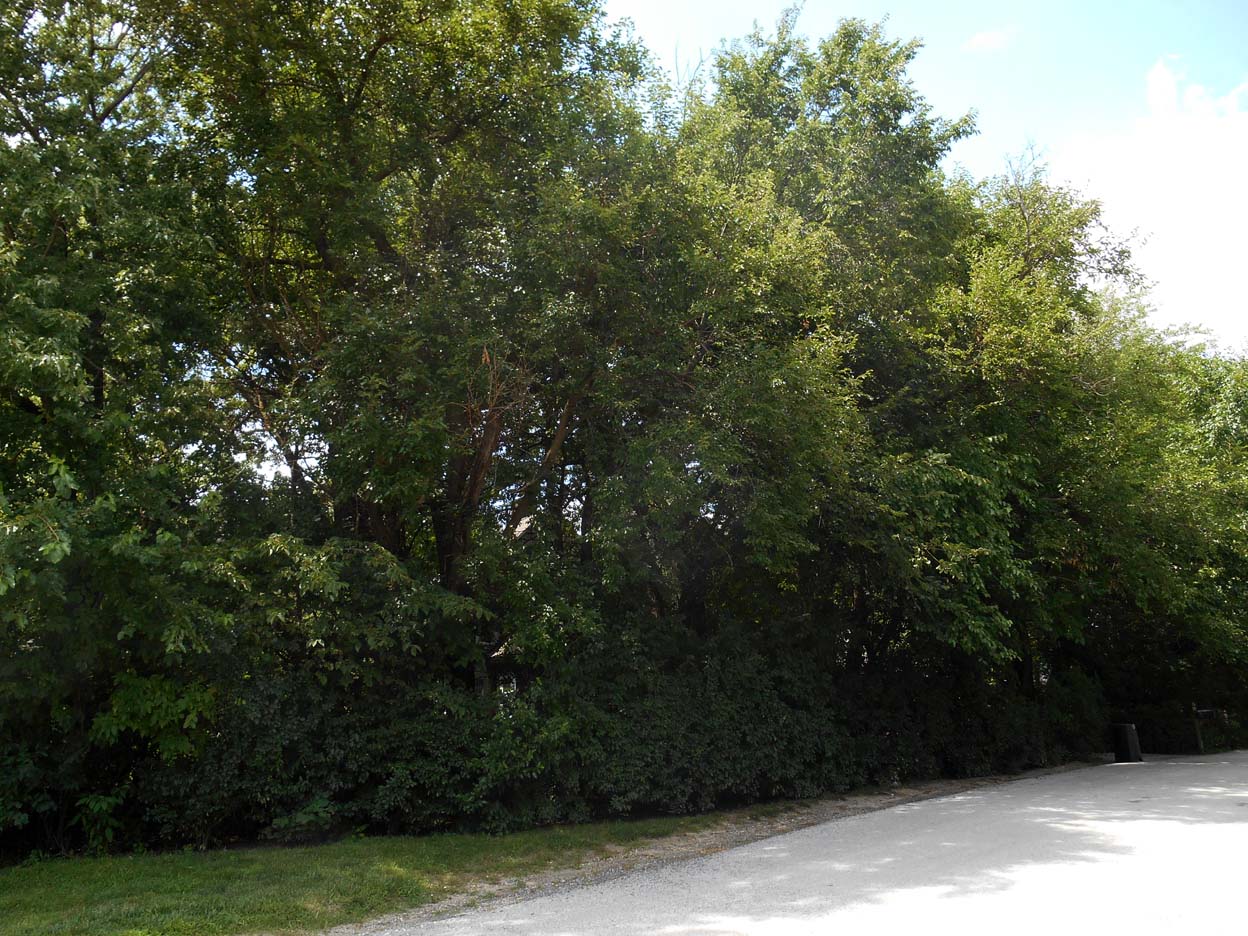 Behind that wall of trees is a secret garden that should be featured in books.
Behind that wall of trees is a secret garden that should be featured in books.

From June 21, 1959: “Rustic New England is caught in every detail—walnut beamed ceilings—paneled library with fireplace—4 1/2 baths and 5 bedrooms—Fully air conditioned—rec room—3 car garage—strikingly beautiful full acre. 8120 PACIFIC.” Why was I so excited to finally get confirmation to the interior of this home? I was pleased to hear that the three-car garage I had spied was from an older time period; although I could not be sure it was original to the home.
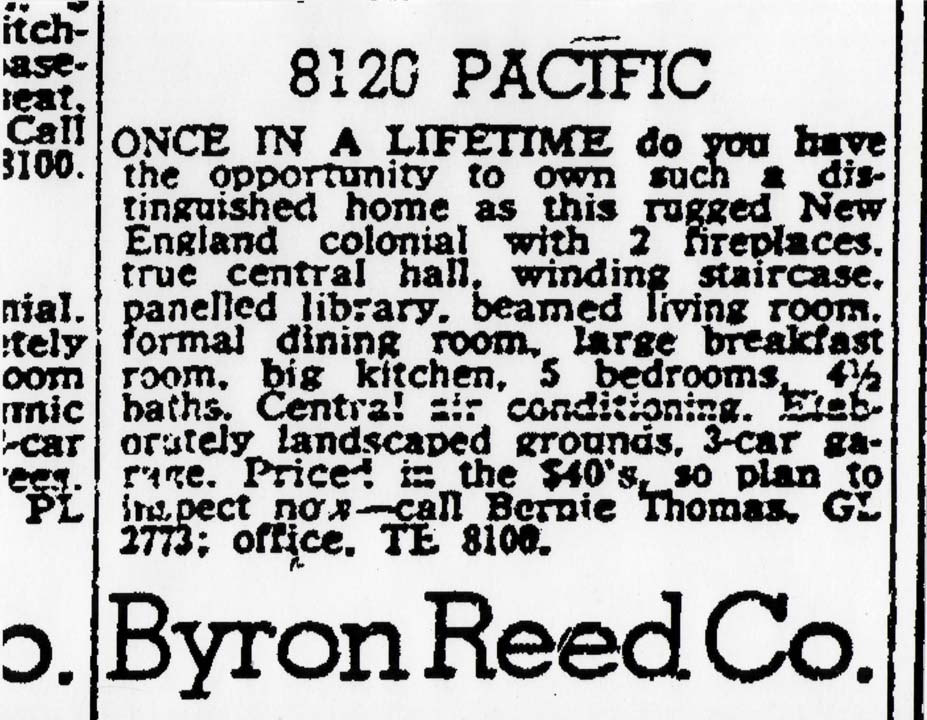
Bryon Reed House April 17, 1960 ad
But this one. Get a load of this one. Now this is how you write a real estate advertisement. “8120 Pacific Stately New England Colonial residence surrounded by beautiful garden, lovely shrubs and trees for utmost privacy. True CENTER HALL PLAN with front and rear exit. Stunning open stairway, pegged-oak floors that continue into 30-ft living room with stone fireplace and floor to ceiling windows, formal dining room, lovely big breakfast room that overlooks gardens, big party-size kitchen with abundance of built-ins, dishwasher-disposal. KNOTTY PINE LIBRARY lined with bookshelves and boasting a quaint tile fireplace. MASTER BEDROOM with ceramic bath, fabulous closet and storage space. 3 other twin-size bedrooms and 2 baths upstairs. 5th bedroom and bath on 3rd floor. Combination cabinet GAS heat and 5-ton air conditioner, screen porch, lovely arbor leads to 3-car garage and wide turn-around drive. Interior of garage paneled in knotty pine—the perfect spot for casual summer entertaining. Large barbecue. IMMEDIATE POSSESSION. Priced in the $50’s. Your inspection invited. Call Howard Cooke. RE 2807; office JA 8100.” Dying. Just dying. The garage was also paneled in knotty pine for summer entertaining? This was just brilliant. I longed to see this place for myself.

Aaaaw….the cupola. Can you see it?
In August of 1960 Ace R. and Carol Cory sold 8120 Pacific Street to Merrill Eaton. Ace Cory would go on to accomplish many honorable, environmentally focused achievements after his time in Loveland. From his obituary of 2005, I learned that Ace had later married Constance Jewett Cory, moved back to Iowa and had four stepchildren. I am going to include this from his obit, because it is quite awe inspiring. “Among his many civic contributions in Omaha, Mr. Cory served on the board that created the original Air and Space Museum at Offutt Air Force Base. At the age of 57, Mr. Cory left the investment business to farm his own land in Northwest Iowa. In the 1980’s he founded his own real estate company, Ace Cory Realty, concentrating on homes in the Iowa Great Lakes region. A farm owner for most of his life, Mr. Cory was a pioneer in modern soil conservation techniques. He won an award from the United States Government for his inventive approaches to minimum tillage. Over the years Ace Cory devoted more and more of his time and energy to the quality of water, air, and land to be inherited by future generations. He was instrumental in the formation of the Dickinson County Water Quality Commission, the first and only organization of its kind in Iowa. For two terms he held the post of president of the Okoboji Protective Association, and he co-founded Friends of Lakeside Lab. He also became a regional director of the Nature Conservancy. During the last decades of his life, Mr. Cory focused on the threat to water quality and safety posed by large-scale industrial hog farms. He joined forces with local farmers and with environmental leaders from across the nation in an effort to protect natural resources and human health from industrial agricultural.”

Winding paths. Mr. Cassette would love to stroll around here with a toothpick in his mouth.
The Merrill and Louise Eaton Story
Merrill Eaton bought 8120 Pacific Street in August of 1960. The detective trail leading to Merrill and Louise Eaton was a faint one, albeit filled with intrigue and mystery. Where the previous homeowners of 8120 Pacific had been socially well heeled, focused on religious community, civic minded, prosperous and active in their country club pursuits, and featured prominently in the papers, the Eatons were of the scholarly world. Academia guided this couple. Both Merrill and Louise were well known child psychiatrists in town. They both worked at the Nebraska Psychiatric Institute. In fact, according to the City Directory, Merrill was listed as clinical director of Nebraska Psychiatric Institute. I thought I was unfamiliar with this institute but soon located evidence to the contrary. The Nebraska Legislature created the Nebraska Psychiatric Institute as an alternative to a fourth state hospital. The Nebraska Psychiatric Institute is still in operation today as a part of the University Nebraska College of Medicine in Omaha.

North side of 8120 Pacific. Brown and light blue together is so divine. My grandmother taught that this was a good color combination when I was young. This reminds me of a gorgeous 1950s dress I used to own.
I found an article from November 6, 1960 where Dr. Merrill Eaton was one of a number of psychiatrists giving a talk on adolescents. This was a course for residents. I soon discovered that he was a professor of neurology and psychiatry at University of Nebraska College of Medicine. I was interested to see that Dr. Louise was also a professor of neurology and psychiatry. In one article she was readying to present a paper on children with cerebral dysfunction.

The Nebraska Psychiatric Institute, or NPI, was located at S 42nd St & Emile St. as part of UNMC. 1960. This stately building has since been demolished. (Photo courtesy of the Bostwick-Frohardt/KM3TV Photography Collection at The Durham Museum Photo Archive).
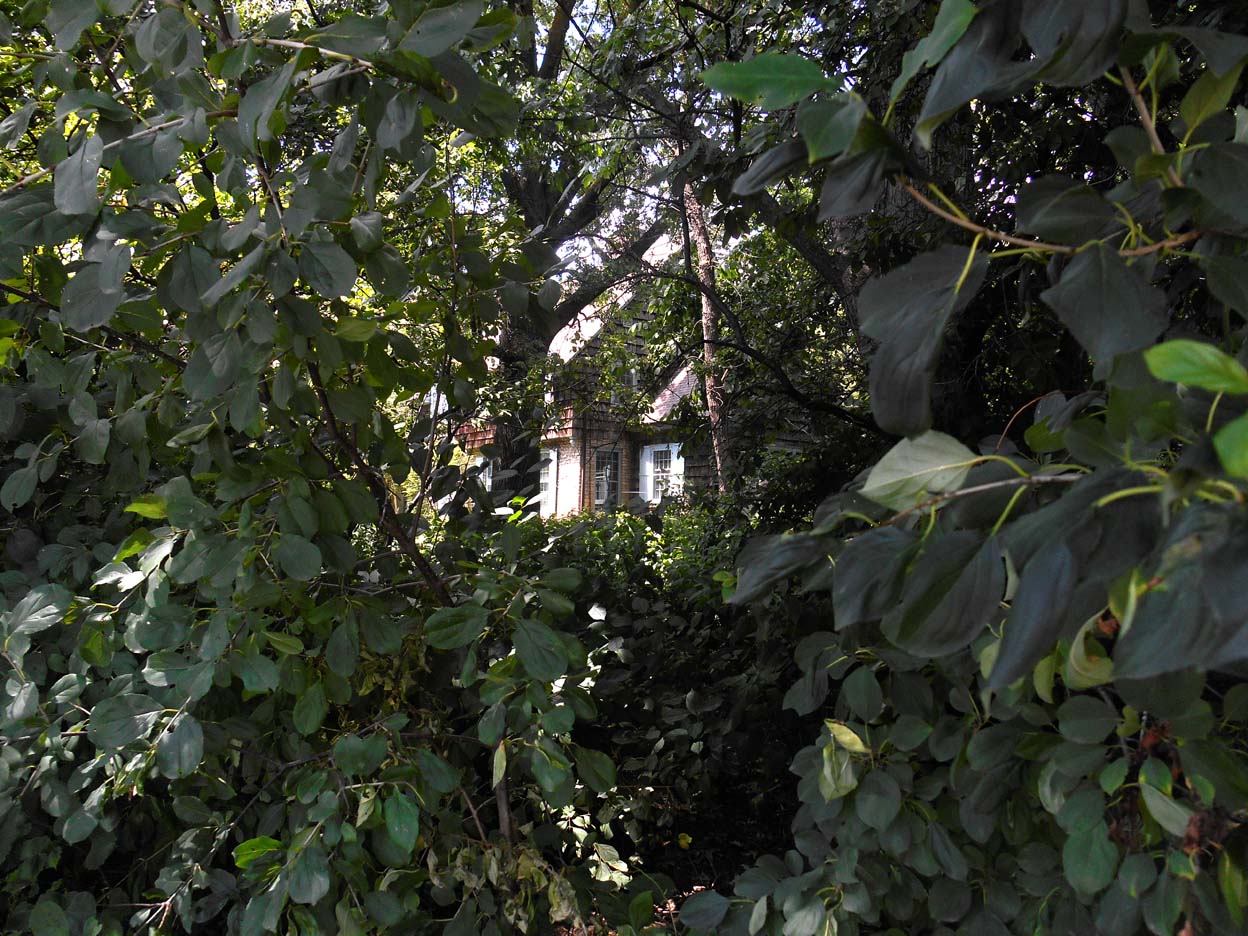
Foliage Window
The Doctors Eaton had three children. In August of 1967, Deirdre was 18, Thomas was 14 and David was 12. They were mentioned in an article about Dr. Louise’s interior decorating of her office at the Nebraska Psychiatric Institute. I realize it was a sign of the times and still a social oddity for a woman to be an MD, but it was puzzling to me why a journalist would interview a well-known psychiatrist about her decorating techniques. The article was entitled, “A Woman’s Inner Sanctum—Warmth of Yellow Walls Pleases Psychiatrist.” There were some breadcrumbs strewn throughout the short spread—of interest, Dr. Louise did not work full time “as her children are still at home.”
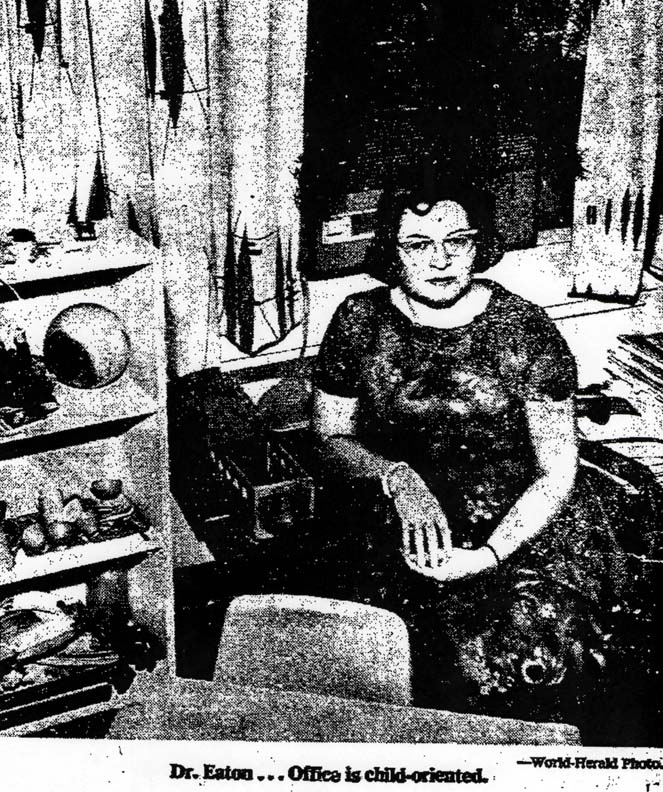
Dr. Louise Eaton. Where do I begin? For starters, I want to know so much more about this woman. The print of her dress. Her glasses. Her hair. Her expression. All very good. I do love Dr. Louise’s choice of atomic barkcloth drapes. One of Miss Cassette’s absolute favorite types of window dressing. Additionally the article mentioned her white leather chairs and an ink drawing done of a kiwi bird by a New Zealand friend.
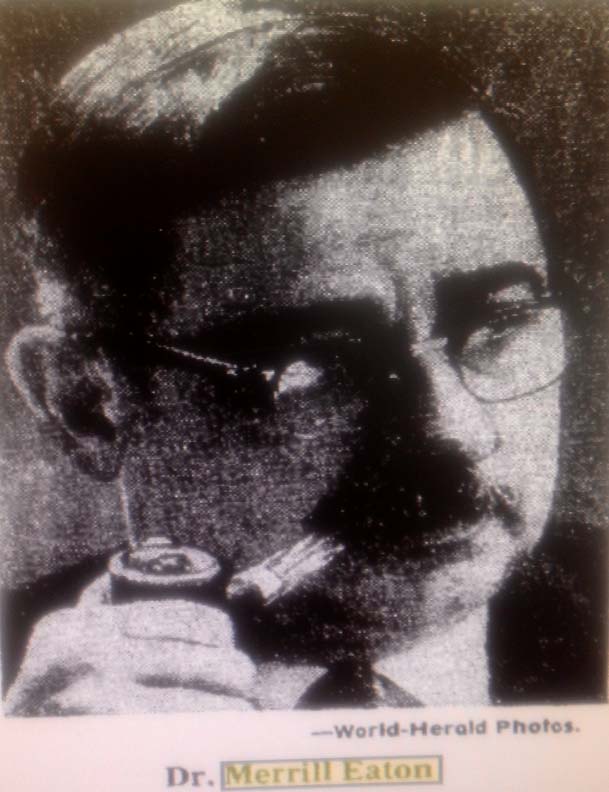
Dr. Merrill Eaton From an OWH article of February 5, 1975, entitled, “’Invisible Entrapment’ Can Hurt.” I just love this photo of Dr. Eaton with his mustache and pipe. Very Psychiatrist Like for this time period. I uncovered that Merrill had authored and published countless psychiatric textbooks and journal articles.
Dr. Merrill apparently spent a year in China researching Chinese psychiatry. He gave a talk on his findings upon his return with over 100 psychiatrists and their spouses in attendance. There was little else I could find of pointers to the Eatons’ interests and hobbies. They were both featured in numerous articles regarding their academic pursuits. Like most involved in academia, they were probably more interested in inclusion of a research journal or getting a book published than being mentioned in a local newspaper. I was quite impressed with this remarkable couple and tried to imagine what life would have been like at 8120 Pacific during their years of ownership. Did they have live in help like the owners previous? I enjoyed thinking of their dinner conversations but couldn’t help but imagine how difficult it might have been to be the children of two child psychiatrists. Perhaps it was wonderful. I could imagine running wild through that beautiful yard or maybe holing up in that knotty pine garage as a teenage refuge.
According to the Omaha Police Department there was a burglary at the house in 2006. A one carat diamond ring was stolen. From the very limited information I could find, Dr. Louise had died previous to 2008. 8120 Pacific Street again went up for sale in 2012 from the “Merrill Eaton Estate,” leading me to believe, Dr. Merrill died sometime that year.
The Eaton Home Interior Shots
These following photos are from the online listings of that sale in 2012. I simply adore all of these photos, as they are so very Midwestern preppy. The Not Decorated Decorated Look of two academics busy with their affairs– their home an eclectic mixture of travels, family heirlooms, and utilitarian purpose. The wear and tear of used and loved goods. Dr. Merrill smoked his pipe here and Dr. Louise might have stayed up late reading a medical journal or a good mystery after she got the children to bed. I treasure these glimpses into their lives.
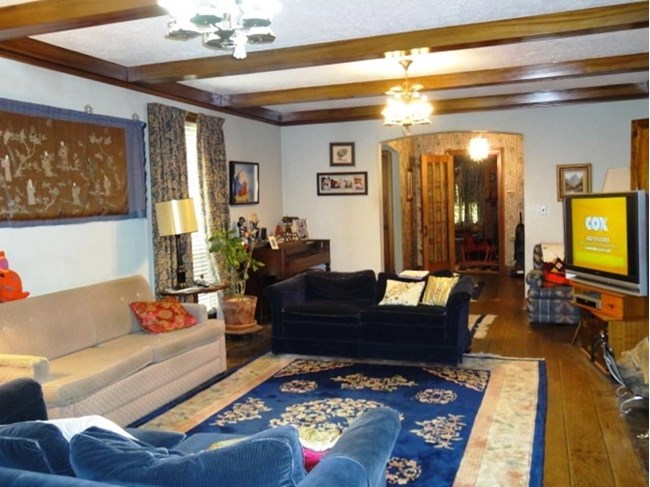
The living room. You can see the Chinese influence. Notice the wide plank wood floor and beamed ceiling. Lovely.

I love the woodwork and wallpaper in this foyer.
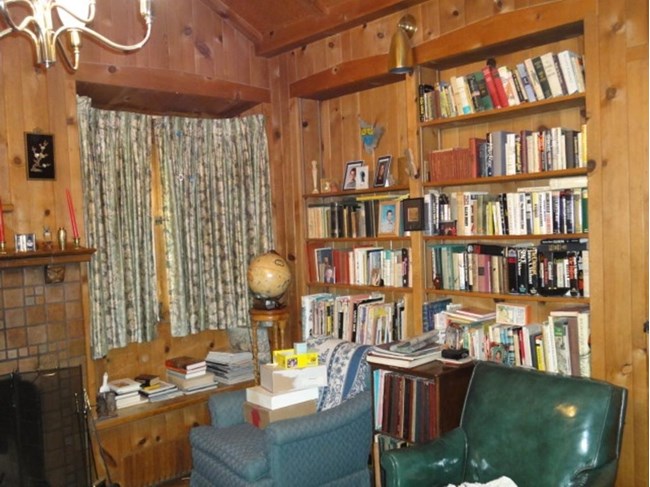
A Model Family Room. The knotty pine study I had read about.
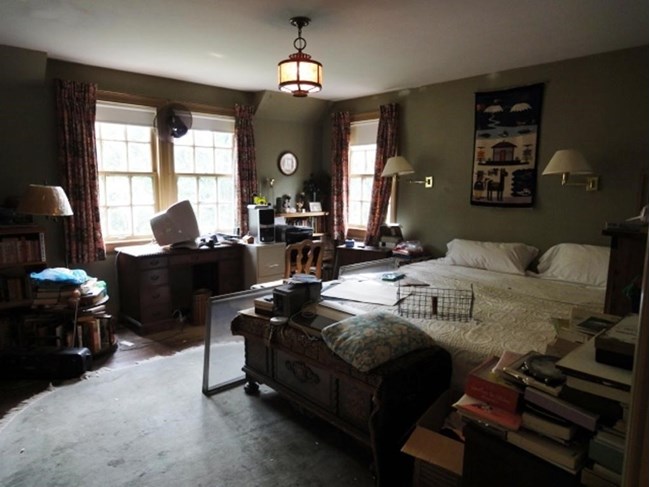
The master bedroom? Excellent light fixture.

Miss Cassette approves of this wallpaper. It looks to be an expensive old school textured grasscloth.

Quaint little kitchen nook.
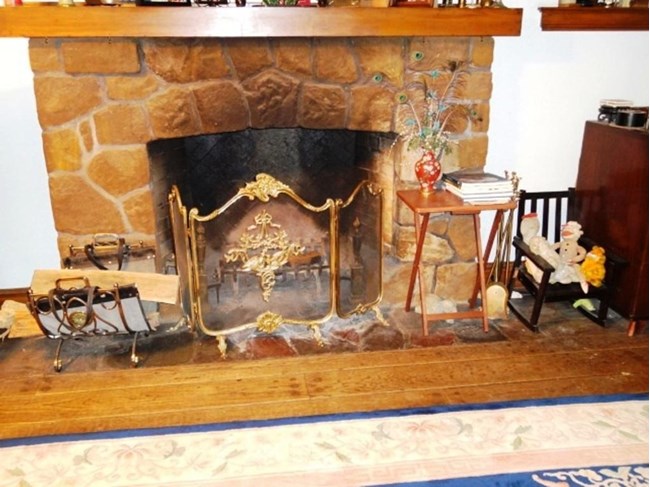
A well loved fireplace is a good sign.

South side of the house. Faces Pacific Street. No longer a front door? This photo is significant in that it shows the first floor made of cobbled stone–often a signature feature of the Shingle Style.
New Owners New History
In June of 2012 the most recent owners moved in. Out of respect for their privacy, I will not publicize their names or professions. Instead I will talk about this glorious property and what excellent stewards the couple has been. It is hard to find a Loveland property that hasn’t been updated to death. It is hard to find an older home that still holds the interior integrity of the original design, let alone the exterior. A skip through CBS homes will show you this commonplace remuddling over and over again. But this new family understood what was intrinsically good about 8120 Pacific. They left the incredible details, even that foyer wallpaper that I covet, and minimally updated the rest. The knotty pine study is still intact. It is all still there. Let me assure you that I don’t know this couple and I do not work for a real estate company. In fact, I thought this home had sold quite a while ago. As it turns out, I believe it is still for sale.
Here are the incredible photos of our girl, 8120 Pacific Street, my beautiful New England Shingle Style country home. Check out the nice updates they have made. 8120 Pacific Street has had an incredible history, is important to the Loveland area and the families she has sheltered. May she live long and continue to be treasured by loving families for years to come. This house mystery now has a part two with even greater detail. Please check it out at Mysteries of Omaha: 8120 Pacific Street Part Two.

View from the foyer to the living room.

Thank you for not destroying this classic bathroom.
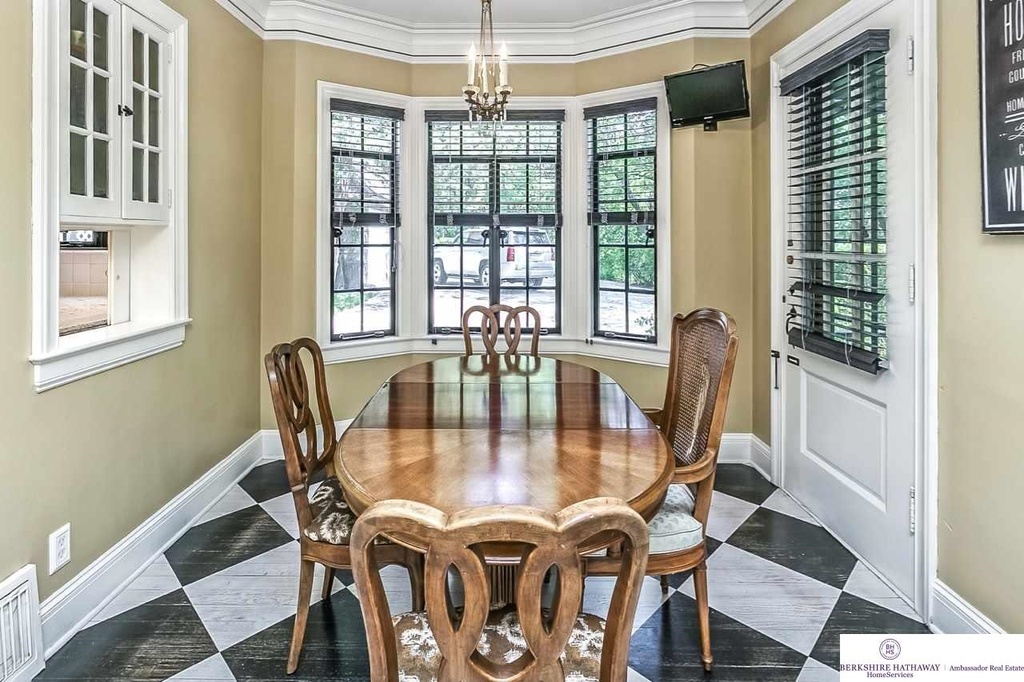
The kitchen nook. Same hanging light.
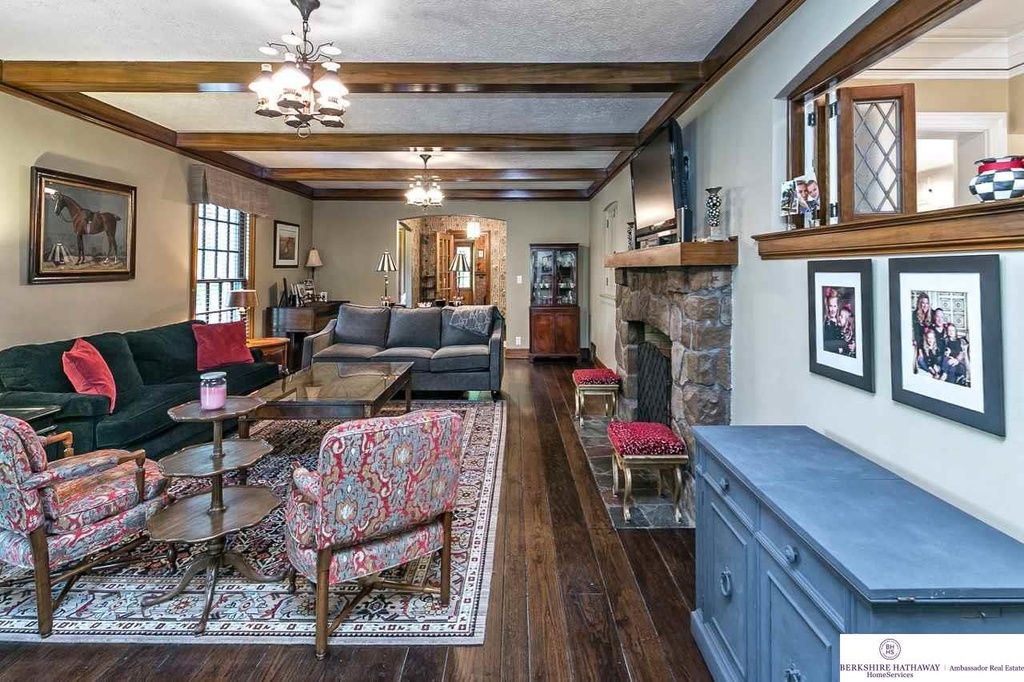
Living Room
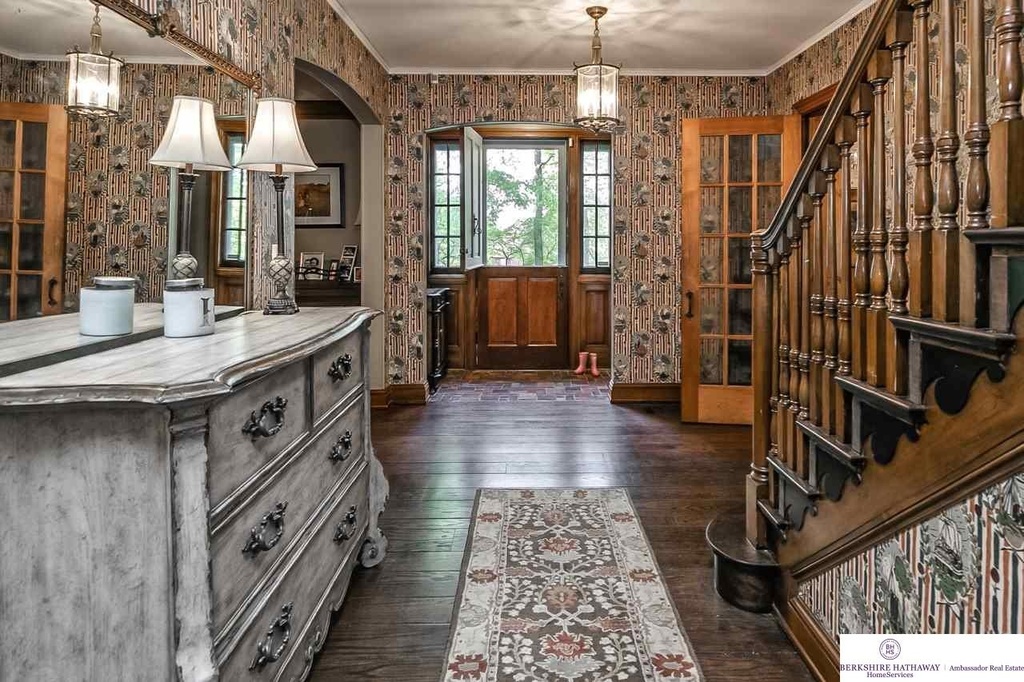
My wallpaper.

The knotty pine study.

The beautifully trellised arbor path leading from the porte-cochere to the garage.

The garage.
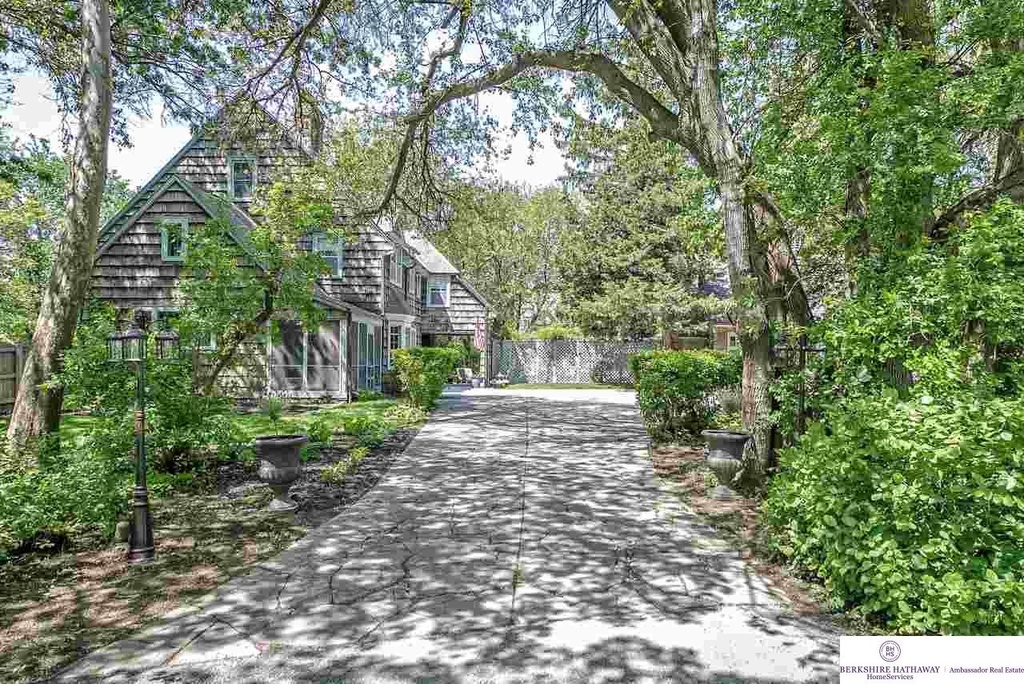
I have really enjoyed researching this property, one of my favorite Omaha homes. I welcome your feedback and comments on this home, its history of incredible owners and the Loveland area. To enable comments, please click on the header title. If you would like to correspond with me privately, please do so at myomahaobsession@yahoo.com. But I assure you, everyone would love to read what you have to say and it makes the conversation more fun. Please sign up to follow this blog to receive alerts on my new articles. Thank you for reading my articles and get out and investigate Omaha when you can!

© Miss Cassette and myomahaobsession, 2016. Unauthorized use and/or duplication of this material without express and written permission from this site’s author and/or owner is strictly prohibited. Excerpts and links may be used, provided that full and clear credit is given to Miss Cassette and myomahaobsession with appropriate and specific direction to the original content.
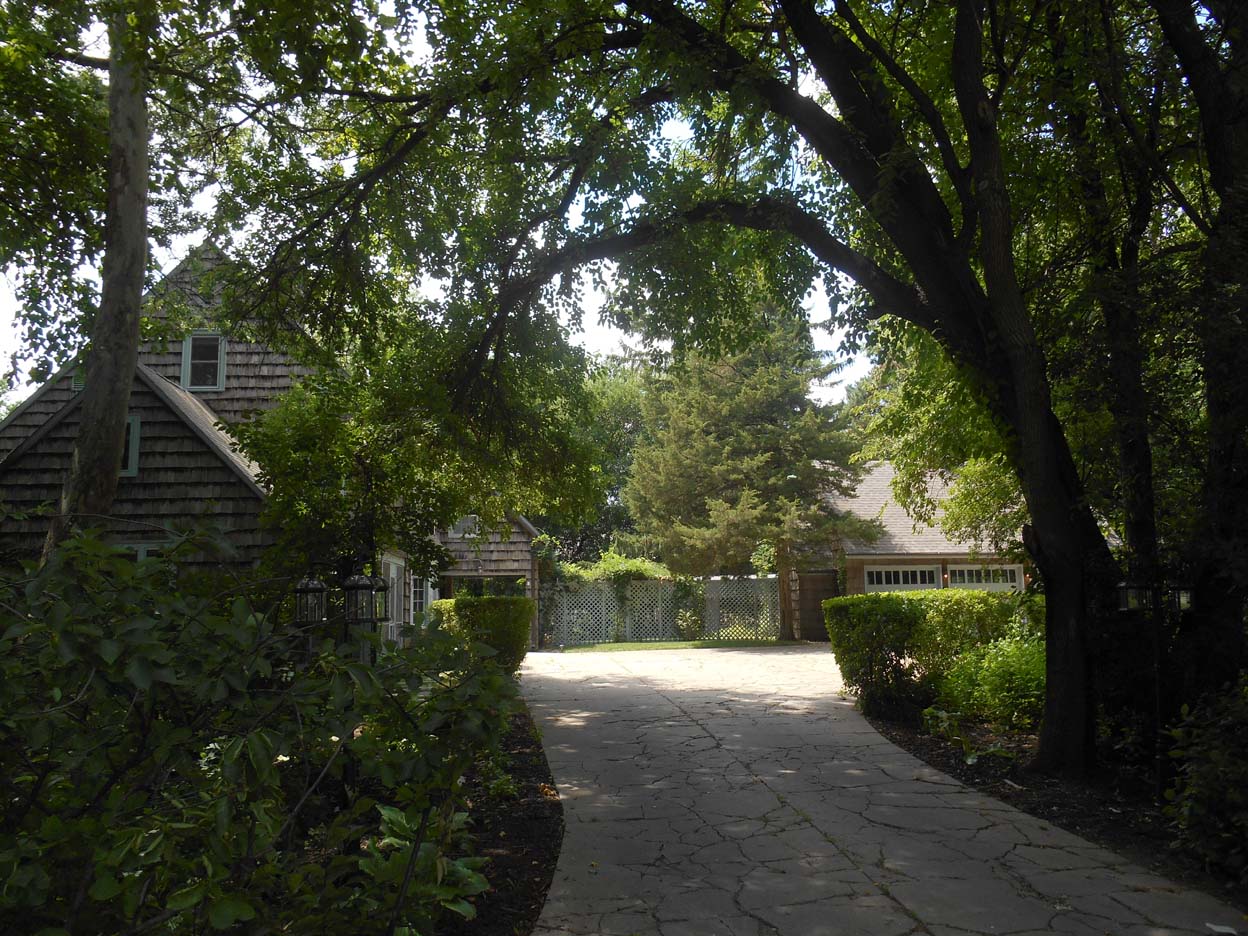
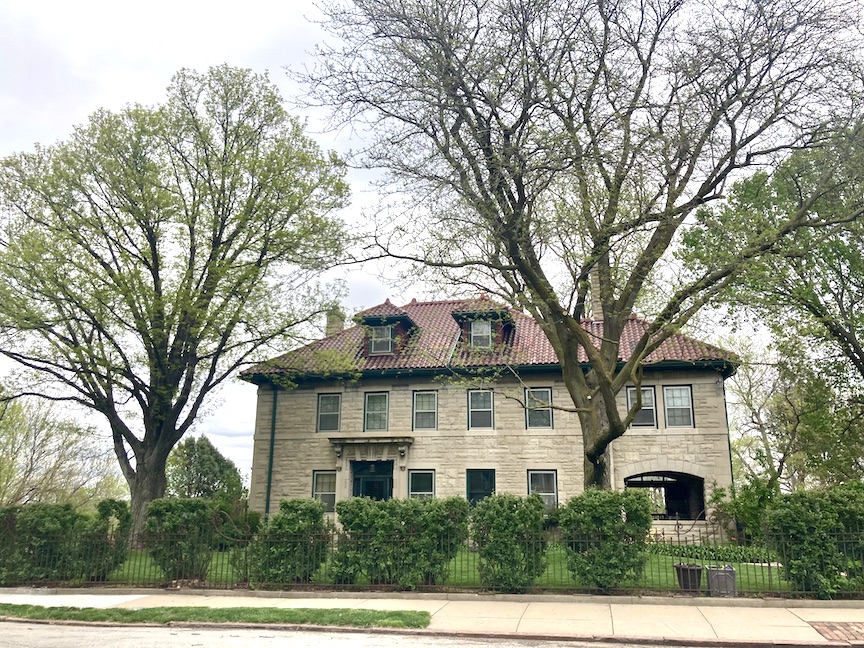
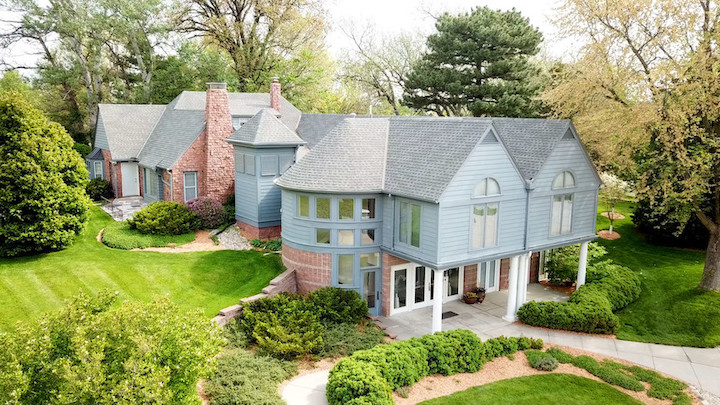
I wonder if they are plagued with silverfish. We recently replaced a shake roof and subsequently got rid of a 20 year silverfish issue. I too love that neighborhood and have fond memories of visiting a friend who lived on that street.
Oh my gosh. Well I’ve never thought of that. I guess a small price to pay for all that glory.
Hello,
We have lived here almost 3 years now. We have found a couple of silverfish over the years but not too bad. What is really bothersome is the spiders. Because of all of the wonderful trees we have big fat hairy spiders who love to build webs around the yard. It does help with mosquitos a bit but I really hate accidentally walking into the webs when I’m gardening !! We spray every spring which keeps them at bay indoors but they just keep coming back outside. I’m out with the hose almost weekly spraying down the webs but it is indeed a small price to pay to live in what feels like a magical house!!
Loved reading this! Thank you for sharing another wonderful story, Miss Cassette.
Thank you. It was fun for me. In fact I took another spin down Ridgewood Ave today!
As a life long Lovelander and the current person in charge of archiving our school’s history, I can not begin to tell you how valuable this article is! Thank you so much!
Thank you! Oh that makes me feel so good. It is such a great area. I want to do more digging!
I’m happy to assist you. Please email me. I think I’ve got some treasures you will love!
I will certainly do that. Thank you so much!
Karin I would love to see the treasures you have, as I too am a life long lovelander!
I believe that Nancy Farber and her husband, Harlan Noddle, lived at a house very close to the one mentioned in this article, on the corner of Ridgewood Ave and Jackson. My parents moved into 604 Ridgewood Ave in about 1960 and I grew up there. I went to Loveland for Kindergarten and 1st grade. The picture where all the streets come together was always known as “5 corners”. As kids, it was where we would meet to play and ride bikes, and also catch the school bus. We knew everyone in the neighborhood and it was great growing up there. Thanks for bringing back so many memories.
The Five Corners! I love it. Yes, I can really see that with the big white gorgeous house set back on the hill. How cool. The Five Corners reminds me of the south side of Pacific where wanderers aren’t supposed to wander. Fun and mysterious street planning! Thanks for your comment.
It looks like this property sold in July of this year? http://www.zillow.com/homedetails/8120-Pacific-St-Omaha-NE-68114/75785950_zpid/
Hello,
Yes, you are absolutely correct. I thought it had sold before that too. It was put back on the market. It is still listed under the recent owners’ name on all accounts, so I thought they had relisted it again. But I just heard from the brand new owner who moved in a few weeks ago! I hope to be able to offer a follow up story in the future, as I have on a few other house stories. Thanks for looking out and good detecting!
So enjoyable to stumble upon this! I am new to Omaha. Originally from Princeton, NJ. I noticed this property recently as I live nearby and saw the house go on the market. I am fond of it as well — perhaps, just as you stated, because it reminds me of homes in the east. Thanks for sharing your research and insights!
Well welcome to Omaha! I am glad you found us and particularly happy for you to have found such a great neighborhood. I just took a spin around Loveland today and always feel lifted up when I pass through. Thanks for commenting and take care.
What a gem! I’m so happy I stumbled across your blog. I just moved to Omaha and bought a home on Ridgewood Avenue. I love learning more about the history of a place. It makes me feel more connected to it. I will have to spend hours reading here. Your research is phenomenal!
Thank you so much, Janet! Welcome to Omaha. You landed in just the right spot. I have got to get back to the triangle and do more research on the other great homes around there. I appreciate your words and hope to see you back this way again.
Thank you for all of this storytelling and research. I’ve lived in Omaha my whole life and just now at 53 I’m starting to be interested in all the neighborhoods and how they came about.